
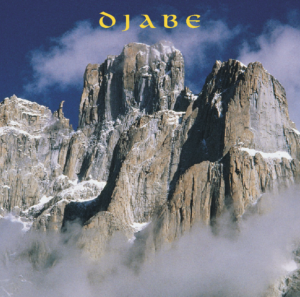 The first album is simply called Djabe. Like many bands over the world, Djabe also thinks of it’s first album as a kind of early age green, but recognize the fandom’s generally positive attitude towards it. The attitude possibly comes from the collage of thriving, and parts of experimental sounding and envisioning that bloomed in the next 20 years, gaining clarity. Here, everything is refreshingly raw, almost unkempt but none at all near chaotic. The introduction states “Djabe consists of Novus Jam members and friends”. Besides the founders András Sipos, Attila Égerházi, Tamás Barabás, Ferenc Muck quartet we have, from the previous band, Judit Gesztelyi Nagy, Tibor Karvaly and Tamás Rácz. Foretelling the future, we also have Ferenc Kovács and his trademark trumpet and violin plays.
The first album is simply called Djabe. Like many bands over the world, Djabe also thinks of it’s first album as a kind of early age green, but recognize the fandom’s generally positive attitude towards it. The attitude possibly comes from the collage of thriving, and parts of experimental sounding and envisioning that bloomed in the next 20 years, gaining clarity. Here, everything is refreshingly raw, almost unkempt but none at all near chaotic. The introduction states “Djabe consists of Novus Jam members and friends”. Besides the founders András Sipos, Attila Égerházi, Tamás Barabás, Ferenc Muck quartet we have, from the previous band, Judit Gesztelyi Nagy, Tibor Karvaly and Tamás Rácz. Foretelling the future, we also have Ferenc Kovács and his trademark trumpet and violin plays.
The album was mostly composed by Attila, with either Sipi or Tibi Karaly as a sidekick in creation. Other Novus Jam musicians and guests were only ad hoc contributors. Djabe was not even the name of the band but just of the albums. In 1997, after the release of the album invitations for gigs were pouring in, and arose a want for creating new compositions. Attila and Sipi decided to create a solid band with stable line-up, to present the premiere of the album. This request was answered by the already contributed Tamás and Mucki. Feri Kovács was otherwise engaged and Tibor was too pre-occupied by his everyday work. This is the story of the duo of Djabe becoming a quartet, in 1997.
I also regard the first Djabe album as a personal favorite. Even it’s cover, featuring white mountains, the photos and drawings of the booklet, the uncanny dome of the Roman Pantheon covered by the disc itself, does it for me. The music, especially with today’s Djabe-tuned ears, is like peaking into a master’s notebook of early works, with drafts and finished or quasi-finished masterpieces. Of course this is not a judgement on quality, a draft can be perfect on its own, like the opening Camel Run, a duet of Mucki and Sipi, the Chase, a bass-conga rush across the savannah by Tomi and Sipi, the tender waves of Attila in Venezia, or the Late Night Drink, with its abundance of guitar akin to Jimi Hendrix-earlies. We hear the Djabe-hymn the first time, for which, 2 years later the well-known clip on the coach concluded, with Mucki as driver and Sipi as ticket inspector, and a colorful women’s ballet. 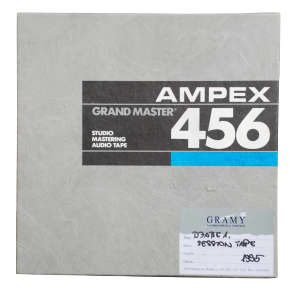 Hungarian-born director László Nagy, now living and working in the States, said: “Who could forget the moment Feri Muck taking the driving wheel of an Ikarus 66 for the first (and possibly last) time in his life, and even reached for his saxophone to play for the camera. Or when Sipi tried to solve the dilemma of opening a door while
Hungarian-born director László Nagy, now living and working in the States, said: “Who could forget the moment Feri Muck taking the driving wheel of an Ikarus 66 for the first (and possibly last) time in his life, and even reached for his saxophone to play for the camera. Or when Sipi tried to solve the dilemma of opening a door while  carrying a large flat screen, with success”. László later directed the short film ‘Coffee Break’ for Djabe.
carrying a large flat screen, with success”. László later directed the short film ‘Coffee Break’ for Djabe.
In Passage the faithful angklung keeps clanking. The four-movement opus of Leaving The Desert is a real pearl for a chamber for music with meditative guitars, thick solos of violin and saxophone and with its main theme, later recurring. Like Wainting For The Distant Dance, a piece that, after multiple reconstitutions, is a permanent element of gigs for 2 decades.
Mike Ezzo said: “One thing I enjoy about the current swell of musical activity in Hungary is the way it proves just how deep the well of quality really is. No single person could ever know all that there is to know about a certain genre. Djabe is just one such example of what I mean. And who knows how many others are floundering in obscurity waiting for someone to pick up on them? This eclectic improvising septet resembles Szamaba (see last issue) in how they come at the jazz target from a skewed angle; hearing how they dance around the bulls-eye without ever fully getting into a typical jazzy swing or groove is most curious indeed. Of the 17 short pieces on offer here, just one fits the standard be-bop song structure. But as the CD advances along, the terrain becomes more and more diverse, taking in references to African music (“Ocean”); Brazilian (“Sorcerer”); pre-Columbian Mexico (“Hagar Aim”); and beyond. “Passage,” for example, features little more than acoustic guitar and Javanese angklung percussion. As with AT Ensemble, no performer on drum set appears. The material however is much looser and free-flowing than AT, but never completely free-form. A strict structure is always prevalent to anchor the experimental pizazz they emblazon their work with. If in the future Djabe can just hit on a signature style, watch out! Recommended then, especially for the playing dexterity, but be prepared for some style jumping.” 
HISTORY
Portion from the book ‘Djabe – 20 years in sounds of freedom’ by László N. Göbölyös
N. László Göbölyös: Djabe – 20 years in sounds of freedom (portions)
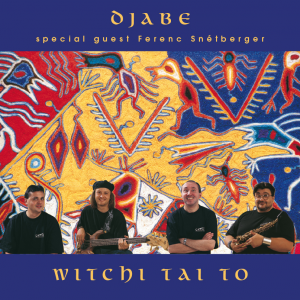
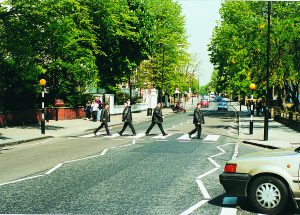
In the beginning, there was that second album, Witchi Tai To. One of its attraction of the time, the extra enhanced CD, containing not only audio and video content, photos and texts, but you could go directly to the band’s website from it. This CD, with a computer partition on it, was produced at Abbey Road Interactive Studio, behind the walls where Beatles, Pink Floyd, Kate Bush and Radiohead worked. Some radio-friendly mixes were on it too, as the main audio content, played by radio stations now and then, but this kind of media cooperation reached a break…
A photo stands as proof the four boys crossed that famous northwest-London crossing, like everybody does if walking there, but looking it more closely its actually Atti, times four. And the arabesque, Native American-design disc was released on LP and MC formats too. A year later, a VHS titled Witchi Tai To Tour came out, featuring the 1998 November gig at PeCsa, swimming in Vari*Lite lights, surrounded by Gábor Bakó’s ring of dancers.
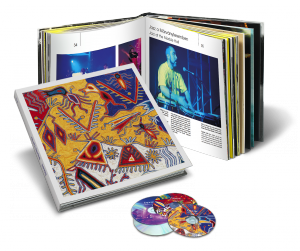 On the album’s 15th birthday Tomi did a complete remixing from the original multitrack. He improved the sounding of the music, hence the three-dimensional feeling of the surround 5.1 version – and of course the high-grade fidelity of the acoustic instruments: even the tiniest detail, smudged on generic stereo, now comes forward. More add-ons were the live video record of the original gig from 1997, and the clip of Djabe and Coffee Break. But this is still not the final destination: in 2015 the band released a 2CD + 2DVD historic release of Witchi Tai To, with interviews, 3 hours of live video recordings in an LP-size artbook.
On the album’s 15th birthday Tomi did a complete remixing from the original multitrack. He improved the sounding of the music, hence the three-dimensional feeling of the surround 5.1 version – and of course the high-grade fidelity of the acoustic instruments: even the tiniest detail, smudged on generic stereo, now comes forward. More add-ons were the live video record of the original gig from 1997, and the clip of Djabe and Coffee Break. But this is still not the final destination: in 2015 the band released a 2CD + 2DVD historic release of Witchi Tai To, with interviews, 3 hours of live video recordings in an LP-size artbook.
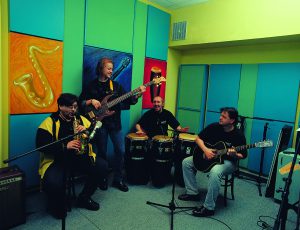
How these pieces of a milestone were born? Atti will guide us through the story.
I heard a few sentences at one of my archive-days, when he was dictating, the whole story to one of his employees in the office, carefully rephrasing every bit again and again. I heard that the opening Coffee Break, Muki’s most known composition, with Ferenc Snétberger manning the guitar, was thought to be a hit by the band; and actually, they were right, as its remix was often played at many radio stations, and even made it to the Juventus Radio remix-CD. Ode was pretty well known already from the second Novus Jam and first Djabe album – on the former it was under the alias Northern Adventure. The original was written by Atti, in 1994, under the influence of solo albums by David Gilmour (for me, Weather Report came to mind when listened to the main theme middle part). The Island enclosed light reflecting off the sea, photographed by Attila, and made into the piece Island (in the Novus Jam era), would be quite perfect for me, too.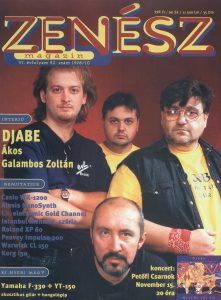
„In the early 90s I mostly recorded my improvisations on cassette or reel-to-reel tape. Often, I found myself going through these recordings and editing them into real pieces. This is how Odyssey came to be, a simple but clean melody, at least for me. We added Sipi’s clay drum and a fretless bass guitar, and finally, Tomi made it whole. I somehow thought about sirens, these legendary sea born creatures, when listening to it; so, we asked Judit Herczeg, Tomi’s wife, to add some vocal to strengthen this siren’s song.” – said Attila.
The scenery after a refreshing rain, with sparky and obscure lights and odors, all try to send the sensitives to a kind of alpha phase. Visions After The Rain is the most „world music-like” piece on the originally made-to-order series Visions. But nobody can stop me at Early Morning Show; for me, it is the twin to Late Night Drink of the first album but made more serene by acoustic instruments. At the next ’vision’ called Cocktail Sipi’s vocal and Tomi’s bass guitar both break free. If a musical composition has depth and meaning it can withstand numerous versions, rearrangement or splitting. A fine example for this is Desert, having a main role early as the album Djabe. The four themes became three, and the second gives the first opportunity for a bass solo for Tomi – a first, but not last occasion. The movement of homecoming is a returning theme for the band: here, it takes the shape of a festivity of drum and vocal.
If there is a real African piece on the disc, it must be Visions, a composition built upon the original corporate-dance gig. The piece shows how inevitable are the masters. We can see the dance choreographed for it, at the beginning of the recording from 1997.
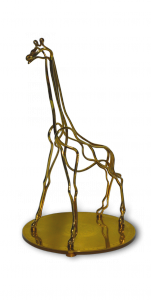 „I listened to the music, made by a completely different state of mind from the generic ad-type jingles and pieces. It does not want to bathe in quick and volatile success, but starts slow, builds up continuously, sometimes even repetitively, then a theme explodes and runs along with us, into an unknown world – in one word, it’s interesting.” – said Gábor Bakó, who met with Sipi and Atti in the Novus Jam era. Sipi’s vocal, kalimba and djembe brings back some antediluvian simplicity – this was the other piece, besides Djabe, that was laid to rest together with Sipi, because „without him, there’s no point in playing it”.
„I listened to the music, made by a completely different state of mind from the generic ad-type jingles and pieces. It does not want to bathe in quick and volatile success, but starts slow, builds up continuously, sometimes even repetitively, then a theme explodes and runs along with us, into an unknown world – in one word, it’s interesting.” – said Gábor Bakó, who met with Sipi and Atti in the Novus Jam era. Sipi’s vocal, kalimba and djembe brings back some antediluvian simplicity – this was the other piece, besides Djabe, that was laid to rest together with Sipi, because „without him, there’s no point in playing it”.
Roots of Gallop stretch back to Novus Jam also, as it was the joint composition of Atti and Judit.
„A piece undefinable by genre – a statement that became true for numerous Djabe compositions in the future. It’s Djabe, period.” – said by many. In its dynamics, provided by Atti and Muki, and a guitar creating a western-like atmosphere, not even far from free style. And for contrast, the saxophone-orientated Last Vision.
„Water spirit circling over my head, I’m happy to be alive.” – as some sources translate the titular Witchi Tai To. This is the only piece that is not original Djabe, but from the Native American saxophonist Jim Pepper, based on a religious song of the Native American Church, a fusion of Christian and Native American religion. A song rehashed by jazz musicians, rock bands and now, even Djabe. But why did this song become the album title? We can learn this from Atti: „It was my idea. It’s a well-known song for our potential fan base, both foreign and domestic. It makes it easy for both shops and shoppers to position our release.”
The idea came true, as this release is one of the most popular of Djabe’s discography, and until Sipi’s death the last piece featured heavily on gigs. And Witchi Tai To was the last to be played by Sipi, on his last performance in Debrecen, on the 7th of December 2007. Did he know this is his farewell? Either way, it was worthy of him.
„Privately released, up to par.” – this was the title given to the article detailing the album press release in the journal Hajdú-Bihari Napló, by Péter Héty. He also added that the band, giving a sneak peek of the new material in Park Café Budapest, „just gathered a ton of praise with its live performance of disc-like quality.”
The multimedia method received praise even after its release, September 1998, from a journalist of Sulinet: „They released a marvelous double CD. On the first disc we find an eerie beauty of clear music, but the second brings the multimedia: four remixes almost jazz-acid, and 35 minutes of live Djabe show.”
A Student E-nek adott interjúban Sipos András ekképp fejtette ki a Witchi Tai To kapcsán világzene-értelmezését: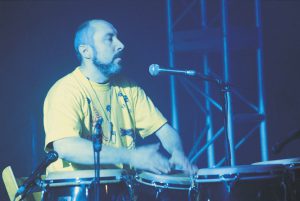
In an Interview for Student E, András Sipos said this about Witchi Tai To and his definition of world music: „Pro musicians often say world music is mostly amateurish, as so many play it who knows absolutely nothing about the language of music as a profession. However, its also clear that the better musician you are, the further you can fly away, because all heights have deep roots. If someone has a good enough relation with the chosen instrument then surely, that musician can let go long enough to breed something special, a musical experience to last.
The most important about world music is its unmistakable base rhythm. Sometime after you can’t even sense the difference between a shaman from Siberia and one of the Dakota people. Instrument-wise they not even close, but the rhythm, that base rhythm is the same. These are genetic codes, not to be changed. And so, we can’t ignore the basic laws of music. Instrumentally, we play world music, but spiritually, we abide the laws of music.”
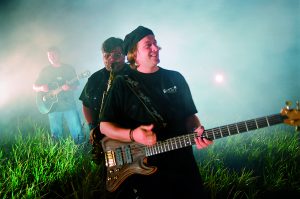
We are accustomed to Djabe sharing its archive treasures with fans, or we can say they place their creations into historic scenery. And it is the same here, too. We even invited to the studio to witness the birth of a piece. Besides the original recordings we can listen and watch some portions of old gigs. As seen in the film of the 1998 tour, with Witchi Tai To, Djabe perfected the nexus of music, stage lighting (Vari*Lite) and choreography. And some more historic documentation of importance; radio and tv interviews by the band, especially some musical show led by András Sipos, mostly angklung.
„The sounding changes year by year, but this album never seemed outdated.” – said Tamás Barabás, who remixed Witchi Tai To, in an interview about the secrets of studio recording.
„The 4 disc deluxe media book version of Witchi Tai To will definitely become the paramount Hungarian release of 2015, raising the bar for future retrospective compilations. It’s self punishment not to buy this top-quality re-release of a Djabe masterpiece.” – said Jozé, a critic for Ellensúly.
It cannot be argued that the Hungarian Music Award for World Music of 2000 made into the best possible hands. In a genre only partially known by domestic fans, mostly by foreign performers. But no one even suspected then that Djabe soon will leap forward, in the spirit of freedom.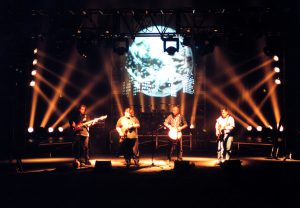
Djabe-klip
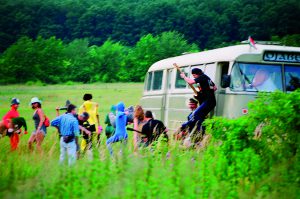 In the summer of 1998, the clip for the radio version of Djabe was made in Budapest, near Petneházy-rét. The script was written by László Nagy, director and director of photography, and by Attila Égerházi, and recorded on 35mm Kodak filmstock. Besides the band members also starred dance choreographer Gábor Bakó and his disciples. For the Djabe popularity, gave a hard push the bus clip, with an iconic, fully operational Icarus 66 type coach. A real specialty was the Vari*Lite lighting equipment used for the outdoor night shoots..
In the summer of 1998, the clip for the radio version of Djabe was made in Budapest, near Petneházy-rét. The script was written by László Nagy, director and director of photography, and by Attila Égerházi, and recorded on 35mm Kodak filmstock. Besides the band members also starred dance choreographer Gábor Bakó and his disciples. For the Djabe popularity, gave a hard push the bus clip, with an iconic, fully operational Icarus 66 type coach. A real specialty was the Vari*Lite lighting equipment used for the outdoor night shoots..
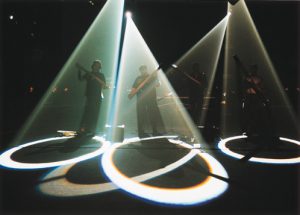
The Witchi Tai To Tour of autumn, 1998 showed off this album with one of the most memorable and spectacular gig series of Hungary. This level of quality was not accustomed to in jazz and world music band stages before. Unparalleled audio quality, Vari*Lite lighting, dancers and the music left the fans completely charmed. The tour lasted till summer of 1999.
Yoruba magic in the theater
„The Djabe quartet gave an elemental gig of world music in Nyíregyháza. Obscured lights, thick smoke, a stage packed with exotic musical instruments – this is what lucky audience of 200 was welcomed by in the Móricz Zsigmond Theater. The quartet literally charmed this audience; this young band just released its especially high-quality double CD album Witchi Tai To, and this was the base for the one-and-a-half-hour-long show (because this was a show, not a gig!).
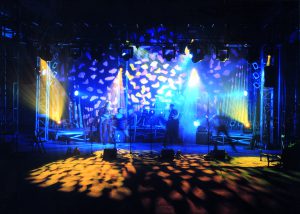
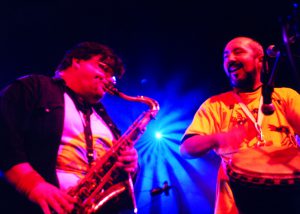 The saxophone play of Muck, the virtuoso bass guitar play by Barabás also strengthen this statement. So, the audience sat there, in the gradually darkening auditorium, then suddenly four human-sized shadow stepped on stage just to fiddle with dong-like instruments – and then, a tropic rain started to pour! Like in Burma, in the middle of a rain forest. The sound effects were frighteningly authentic. And this is how it was, until the end of the concert. Visions After The Rain, Ode, Island, Camel Run, Desert I-III, Visions, Distant Dance. And of course, the showoff of exotic instruments also came true. The professionalism of Sipos, especially with the magic of Yoruba, was extraordinary. Soon after, when the quartet performed Javan folk music on wooden fregola-like instruments, well, the audience simply went crazy. This was a night, and a gig, to be remembered!” – said János Kállai, Kelet-Magyarország, 1998.
The saxophone play of Muck, the virtuoso bass guitar play by Barabás also strengthen this statement. So, the audience sat there, in the gradually darkening auditorium, then suddenly four human-sized shadow stepped on stage just to fiddle with dong-like instruments – and then, a tropic rain started to pour! Like in Burma, in the middle of a rain forest. The sound effects were frighteningly authentic. And this is how it was, until the end of the concert. Visions After The Rain, Ode, Island, Camel Run, Desert I-III, Visions, Distant Dance. And of course, the showoff of exotic instruments also came true. The professionalism of Sipos, especially with the magic of Yoruba, was extraordinary. Soon after, when the quartet performed Javan folk music on wooden fregola-like instruments, well, the audience simply went crazy. This was a night, and a gig, to be remembered!” – said János Kállai, Kelet-Magyarország, 1998.
Portion from the book ‘Djabe – 20 years in sounds of freedom’ by László N. Göbölyös
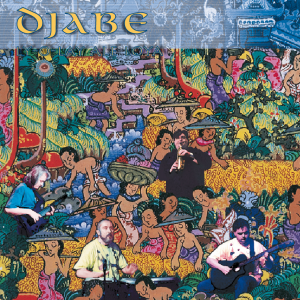 “NEW ALBUM, NEW COLORS –
“NEW ALBUM, NEW COLORS – 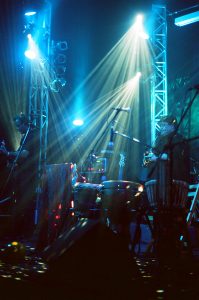 I feel the most important about this album is the consistency of Djabe’s music. That consistent mentality of theirs (since Novus Jam) about musical ideals. They did this before trends, created their own musical world, and the real world just caught up with them. Djabe knows everything about music that is needed to know. Accustomed to and heeding each other, as it is evident by their compositions. Precisely composed pieces and solos that every time give the feeling of just being born. Humorous and lyrically placid, free and flowing pulsation, and lyricism changes all the time without getting sentimental. Ly-O-Lay Ale Loya means quality in a sea of mediocrity. Not some ambient music, it needs to be listened over and over to see all the colors. It’s a bridge between distant cultures, moods, emotions, and people.”
I feel the most important about this album is the consistency of Djabe’s music. That consistent mentality of theirs (since Novus Jam) about musical ideals. They did this before trends, created their own musical world, and the real world just caught up with them. Djabe knows everything about music that is needed to know. Accustomed to and heeding each other, as it is evident by their compositions. Precisely composed pieces and solos that every time give the feeling of just being born. Humorous and lyrically placid, free and flowing pulsation, and lyricism changes all the time without getting sentimental. Ly-O-Lay Ale Loya means quality in a sea of mediocrity. Not some ambient music, it needs to be listened over and over to see all the colors. It’s a bridge between distant cultures, moods, emotions, and people.”
– said János Neltz, editor of Magyar Rádió, in 1999, about the 3rd Djabe album, once again reaching for Native American motives. Ly-O-Lay Ale Loya means a counter-clockwise motion, something that takes you out from the order of the world. The song became known in 1995 by the German Sacred Spirit Project (Chants and Dances of Native Americans), a New Age band supporting a foundation for Native American rights. The motive’s origin became a subject of debate: some said Ly-O-Lay Ale Loya is not Native American but Lappish. However, some music expert pointed out that the Lappish shaman singing style, called Joik, strongly resembles rites of numerous north tribes of Native Americans. Again, a bit of information highlighting the essence of World Music…
Many versions of this song are known, but the Djabe version may be the most intense, sounding like a deep mantra, not just in Sipi’s vocal but in Tomi’s bass-plea. However, this intro is just one of the many sounds on this album. Back then Djabe was not touring international, but we can almost travel around the globe with help from the excellent photos and landscape-inspired music, from the Mayan pyramids to Indonesian islands. The head tour guide is Sipi, all the percussions came to life under his hands: hand drum and rainmaker, conga and djembe (called the king of drums by him).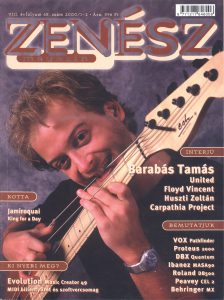 “African folk music come into view even more than before. Congas play 1000-year old rhythms: talking to the listener’s long forgotten basic instincts, awakening them. Sometimes it calls for a dance, sometimes it’s like a monologue: distant but understandable messages.” – said Sipi in Vasárnapi Hírek. In pieces Bali Waves, Wizard of Uxmal, Playground, Bali Trees he is the hero, while he completely owns Djolé. The latter is a part of a West-African ritual blessing newlyweds or abundant harvest. Then comes the collective angklung, which became a stage tradition for the band. Even a sound-check had been recorded, with Sipi and Tomi (Atti being the sound engineer, fortunately); we can hear they’re having fun, so can we.
“African folk music come into view even more than before. Congas play 1000-year old rhythms: talking to the listener’s long forgotten basic instincts, awakening them. Sometimes it calls for a dance, sometimes it’s like a monologue: distant but understandable messages.” – said Sipi in Vasárnapi Hírek. In pieces Bali Waves, Wizard of Uxmal, Playground, Bali Trees he is the hero, while he completely owns Djolé. The latter is a part of a West-African ritual blessing newlyweds or abundant harvest. Then comes the collective angklung, which became a stage tradition for the band. Even a sound-check had been recorded, with Sipi and Tomi (Atti being the sound engineer, fortunately); we can hear they’re having fun, so can we.
“Deep in the water or high in the sky – what’s the difference?” – the great question arise from the tranquil guitar Underwater Sunlight, and waiting for us inbetweeners to answer. Similar sounding color of pastel can be seen in Memory of Bells – there, the key was Sagrada Familia, as the music penetrates the building. Above The Skies is written by Attila to the memory of her mother; a chastely sad farewell on a simple nylon guitar, and a bit of Novus Jam-feeling, added by Judit Gesztelyi Nagy.
“Knowing silence – is knowing music.” – said Carl Sandburg and a critic of VH said the same about Memory of Bells: “Sandburg would say the same about this.” I envision Ferenc Móra, talking about people crying on the inside…
Final Word is a real miracle, a sum of calming, its best quality being its moderation. On this album we can feel Tamás Barabás became the hero of the band. As all highly versatile people, he also asked the question: who and what am I? This is Tomi’s answer, for Zenész Magazin, in 2000:
“I am simply a musician. As reading magazines from the USA, there the lines are not so well defined. Someone, if asked, will say: I am a bass guitarist. And will play jazz, pop, rock or anything, as anything goes. With Djabe’s newest album, I did everything I could, literally. I composed, arranged, I did the sequencer programs, played the bass, guitar, percussion. I must say, I never listened to tons of World Music, but maybe this is why I had a different approach, maybe this way Djabe’s world is more unique. Just one example: we recreated African notes by Indian instruments. We did not read the manual – this is why this music became more interesting.”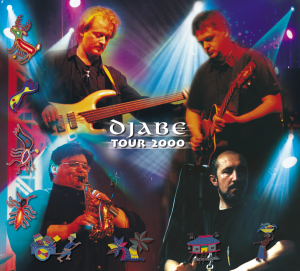
Mike Ezzo had this to say about Ly-O-Lay Ale Loya: “In sharp contrast between earlier Hungarian bands and Djabe, the latter is an international mix, completely eschewing Hungary’s traditions. They turn outward and take in many influences, traveling along the long spectrum of modern fusion, approximating Latino and other ethnic themes. The show, the record and the performance itself is 1st class. First half of the CD is full of funk and rock fusion, kind of showing the quartet in a Metheny-like or Herbie Hancock-like light. A melodic base and little impro, Djabe offers Rock listeners an experience they are not accustomed to. The star of the show is Tamás Barabás, his Jaco-inspired play delivers the missing jazz element. The second part of the album brakes out in duos and solos. 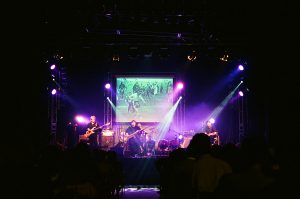 My personal favorite is a wild duet between bass and congas. At the end everyone returns to a simple melodic piece, to finish the album with the frame and structure in mind – I do not see this often nowadays.”
My personal favorite is a wild duet between bass and congas. At the end everyone returns to a simple melodic piece, to finish the album with the frame and structure in mind – I do not see this often nowadays.”
AThis American critic of course could not know that with this release, Djabe just closed an era. The album was premiered on the Ly-O-Lay Ale Loya tour, in spring 2000. Multitrack recordings were made, the PeCsa performance in April was even recorded on video tape. This material was made into an album, released on CD, named Tour 2000. After Lay-O-Lay Ale Loya’s plastic case, Tour 2000 was housed in beautiful paper holder. Then, in the autumn they once again gone on national tour with this material, called Tour 2000. As before, all pieces got a separate and unique visual appearance, but the on-stage show changed compared to Witchi Tai To. 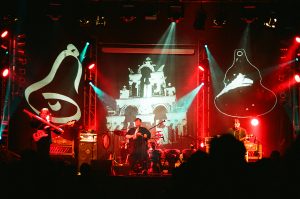 Dancers were left out but built a mechanic canvas right in the middle of the background, sometimes descending and showing the audience cozy videos. Lighting is still based on Vari*Lite equipment, extended by these videos. The gigs played almost all Ly-O-Lay Ale Loya pieces and the first two album’s most important compositions, so all in all these performances were more than 2 hours of musical magic.
Dancers were left out but built a mechanic canvas right in the middle of the background, sometimes descending and showing the audience cozy videos. Lighting is still based on Vari*Lite equipment, extended by these videos. The gigs played almost all Ly-O-Lay Ale Loya pieces and the first two album’s most important compositions, so all in all these performances were more than 2 hours of musical magic.
Portion from the book ‘Djabe – 20 years in sounds of freedom’ by László N. Göbölyös
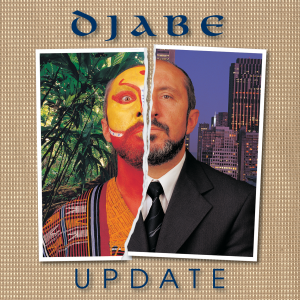
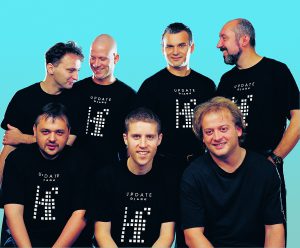 Djabe’s epoch-making band update happened in 2001 by the need for further development. Ferenc Muck place was taken by two soloists, or more like 3 because Ferenc Kovács enriches the band both as a trumpet player and violinist, and Zoltán Kovács (Ko) not only provides new foundations but also classical and jazz-rock inspired and makes Djabe’s music richer with his own solos. The sounds of percussion also changed, as, besides András Sipos, a classic drummer was included in Szilárd Banai: never bothering but strengthening each other. As we could experience this in Santana, Osibisa, the Airforce of Ginger Baker or the Weather Report.
Djabe’s epoch-making band update happened in 2001 by the need for further development. Ferenc Muck place was taken by two soloists, or more like 3 because Ferenc Kovács enriches the band both as a trumpet player and violinist, and Zoltán Kovács (Ko) not only provides new foundations but also classical and jazz-rock inspired and makes Djabe’s music richer with his own solos. The sounds of percussion also changed, as, besides András Sipos, a classic drummer was included in Szilárd Banai: never bothering but strengthening each other. As we could experience this in Santana, Osibisa, the Airforce of Ginger Baker or the Weather Report.
Englishman Ben Castle (saxophone) and Moroccan Saïd Tichiti (vocal, gembri, percussion) also heavily featured in many recordings and gigs. This was the first year for the band to include guest musicians at gigs. The change also included the cover design: on the torn apart, then rearranged photo shows Sipi, his left side painted as an African tribal member, his right side dressed as a modern Caucasian businessman. One side can’t live without the other, just as it is in Djabe’s music; however, Sipi is more like the left side.
Our update begins with the sing of birds and tribal notes (Update is completed), then we take to the sky (Flying). I love to fly, I’ve done it over 100 times, and the ascension talks to me in music. With Flying, we reach travel altitude with Tomi’s tranquil theme, we unfasten our seat belts, accelerate to 900kmph which seems like standing still mid-air, only seeing ever-changing clouds and golden-reddish sunbeams. Meanwhile on the ground, Feri’s trumpet makes place for itself: first with a sordino, then it opens. And then, comes Ben’s saxophone. Oriental wise men say even the longest journey begins with the first step. I don’t know this is what was in the guy’s minds when composing First Step, but even this first step offers many-many directions. Lead Soldier incorporates a child-like naivitée with its 80s-sounding guitar and the following piano by Ko. Clouds 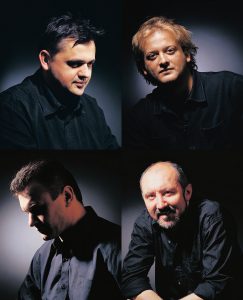 Dance however, is a real evergreen of Djabe. It could even be the pair for Flying, but its scenery is lower, like a flock of seagulls soaring freely on the rhythm of Sipi and Szilu. Who can find the streams of Erdő, erdő at first listening? How can Spanish guitar, African and Turkish drums, Tibetan chimes and Hungarian folklore notes mix as a jazzy violin-piano cavalcade in only 5 minutes? Real bravado! Ben shows us two kinds of desire in Desire: a sensitive (bass clarinet) and a zealous (soprano saxophone). Tomi’s Fretless just dreams on. Mayombe is a Central-African religion of elder spirits and forces of nature. Mayombe sorcerers charm everyday objects (especially sticks and rods). Our sorcerer is Sipi, who plays an entire choir by himself, with Ben’s flute solo right behind him. Winter Forest is a beautiful piece of Atti’s lyre, with a guitar, a bass and a piano painting the silence of nature, while Ben provides life in the stillness. My Way, on the other hand, is filled by just Tomi and the Englishman. This saxophone-bass guitar duel feels intimate, almost confession-like, and the music rises questions for not just the musician but the audience, also. Barraguira shows free-virtues, with Ben responding with tenor-screams to the ‘ördöngös’ of Sipi, Szilu and Tomi. Colours is the private show of our drummer, a tasty funky-like impro summoning the atmosphere of the music of Mark King, Jaco Pastorius and Krzysztof Scieranski. Saïd also gets his chance with Ya Dellali, and right after everyone returns to update Witchi Tai To with Ben’s flute entry, and illustrating the septett’s harmony by sawn-together solos.
Dance however, is a real evergreen of Djabe. It could even be the pair for Flying, but its scenery is lower, like a flock of seagulls soaring freely on the rhythm of Sipi and Szilu. Who can find the streams of Erdő, erdő at first listening? How can Spanish guitar, African and Turkish drums, Tibetan chimes and Hungarian folklore notes mix as a jazzy violin-piano cavalcade in only 5 minutes? Real bravado! Ben shows us two kinds of desire in Desire: a sensitive (bass clarinet) and a zealous (soprano saxophone). Tomi’s Fretless just dreams on. Mayombe is a Central-African religion of elder spirits and forces of nature. Mayombe sorcerers charm everyday objects (especially sticks and rods). Our sorcerer is Sipi, who plays an entire choir by himself, with Ben’s flute solo right behind him. Winter Forest is a beautiful piece of Atti’s lyre, with a guitar, a bass and a piano painting the silence of nature, while Ben provides life in the stillness. My Way, on the other hand, is filled by just Tomi and the Englishman. This saxophone-bass guitar duel feels intimate, almost confession-like, and the music rises questions for not just the musician but the audience, also. Barraguira shows free-virtues, with Ben responding with tenor-screams to the ‘ördöngös’ of Sipi, Szilu and Tomi. Colours is the private show of our drummer, a tasty funky-like impro summoning the atmosphere of the music of Mark King, Jaco Pastorius and Krzysztof Scieranski. Saïd also gets his chance with Ya Dellali, and right after everyone returns to update Witchi Tai To with Ben’s flute entry, and illustrating the septett’s harmony by sawn-together solos.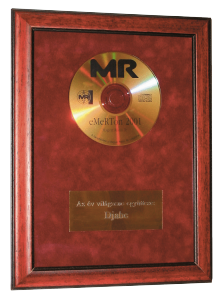
“I think Djabe’s power lies in reaching so many music lovers. If you like jazz, you find jazz, if you like world music, you’ll get a great experience, if you like quality prog-rock, you’ll be astonished. And maybe, just maybe we help genres open up and be more transparent, encourage other projects and productions.” – said Attila at the beginning of Update Tour, in his interview with radio journalist János Neltz.
“The musical world of Update builds upon the world music traditions of the band, while steps forward in instrumentalization and musical motifs. The audience can of course find all the exciting rhythmic and melodies incorporated by András Sipos, who was inspired by African and Arabic sources. At the same time the soloists (Ben Castle, Ferenc Kovács and Tamás Barabás) also give quality performance, both music-wise and technique-wise. Tamás Barabás composed the content of this album from his and Attila Égerházi’s ideas. The audience can see and 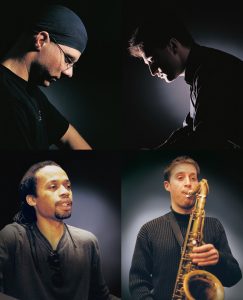 hear a musical (and stage) performance unique to the Hungarian music scene in both style and quality.” – written on Zene-net.
hear a musical (and stage) performance unique to the Hungarian music scene in both style and quality.” – written on Zene-net.
Nowadays many bands release the raw material of some of their albums: rehearsals, recording sessions, pre-finalized versions, but only 20-30 years after the initial release. Djabe, on the other hand, gave this treat to its fans in 2002 titled “Everything you want to know about Update”. They felt like this material is a value in itself. The band and its fans both were gratuitous for the affection: they let them in to show the most intimate part of Djabe’s mechanics. Update received a nomination for the Hungarian Music Award, and then the second most important of domestic awards, the eMeRTon in jazz/world music category, and launched the band for towards international success. AS we all know, during the 2001 album premiere tour in Hungary, Djabe received its first invites to Csáktornya (Cakovec, Croatiia) and Pozsony (Brartislava, Slovakia)
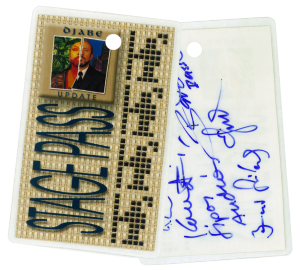 Update tour
Update tour
Update was premiered with a grand tour of Hungary, in Summer 2001 to the end of 2002. The 6-member band was joined by Ban Castle. 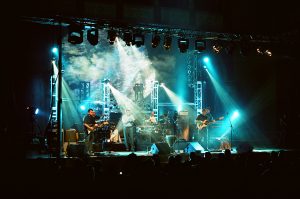 Stage technique remained the quality accustomed to Djabe: Vari*Lite luminaire helped carry on the visuality of the 2000 tour, but without projectors. Instead, 7 musicians filled the stage, upgrading the visual greatly. The more than 60-min first part was filled with older pieces, rearranged. The second part premiered the complete material of Update, only excluding Saïd’s solo (he couldn’t make it to the tour and only re-joined Djabe on stage in 2002).
Stage technique remained the quality accustomed to Djabe: Vari*Lite luminaire helped carry on the visuality of the 2000 tour, but without projectors. Instead, 7 musicians filled the stage, upgrading the visual greatly. The more than 60-min first part was filled with older pieces, rearranged. The second part premiered the complete material of Update, only excluding Saïd’s solo (he couldn’t make it to the tour and only re-joined Djabe on stage in 2002).
2002 – Flying DVD
The gigs held at Petőfi Csarnok and Vigadó in Budapest was both recorded by the band. The best of this material made it to Djabe’s first DVD release, titled Flying. This was the first Hungarian jazz/world music DVD, and the first surround mix of Tamás Barabás. It sounds exceptionally good. It even received praise from Abbey Road audio engineers in 2003, while working on Sheafes Are Dancing. A perfect audio-video footprint of the 2002 tour, this album succeeded abroad, too.
 “Flying – takes to the skies. Djabe – freedom. No other title could be given to this DVD. Once it plays, the flying begins… but where? Not a valid question. No borders, but why should we separate the world? Modern civilizations and ancient worlds fit together perfectly, like a (possibly futuristic) dream. 133 minutes of tranquility… almost unbelievable! 7 different musicians, 7 personalities. Unique ideas, solutions, but always in harmony, inciting, inducing each other to achieve the very best. The only motivation is the love for their music. This is Djabe. And Djabe’s DVD is the best Hungarian release to this day. The whole disc is characterized by crystal-clear acoustic sounding. Perfectly understandable vocals, soft cymbals, the rattling of various little instruments. Dynamic bass, good transients. I am quite satisfied with the wind instruments, also. They have a naturally dirty sounding, because of the ‘wind’ part. Proportions and instrument harmony are perfect, well thought-out techniques and clear visionary is included. Because, if a music is unclear in terms of concept, the musicians cannot be in harmony, and no audio engineer can doctor that. I recommend to anyone who is open to the colourful world, anyone who wants to leave behind everything for 2 hours.” – said Attila Kiss, Digitális Házimozi, 2003.
“Flying – takes to the skies. Djabe – freedom. No other title could be given to this DVD. Once it plays, the flying begins… but where? Not a valid question. No borders, but why should we separate the world? Modern civilizations and ancient worlds fit together perfectly, like a (possibly futuristic) dream. 133 minutes of tranquility… almost unbelievable! 7 different musicians, 7 personalities. Unique ideas, solutions, but always in harmony, inciting, inducing each other to achieve the very best. The only motivation is the love for their music. This is Djabe. And Djabe’s DVD is the best Hungarian release to this day. The whole disc is characterized by crystal-clear acoustic sounding. Perfectly understandable vocals, soft cymbals, the rattling of various little instruments. Dynamic bass, good transients. I am quite satisfied with the wind instruments, also. They have a naturally dirty sounding, because of the ‘wind’ part. Proportions and instrument harmony are perfect, well thought-out techniques and clear visionary is included. Because, if a music is unclear in terms of concept, the musicians cannot be in harmony, and no audio engineer can doctor that. I recommend to anyone who is open to the colourful world, anyone who wants to leave behind everything for 2 hours.” – said Attila Kiss, Digitális Házimozi, 2003.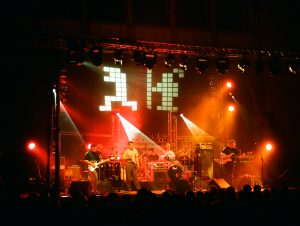
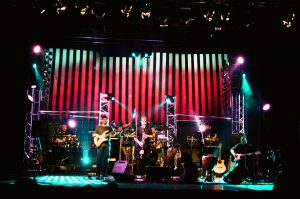
“It is almost unbelievable to see this self-made, fully Hungarian release! And this is the first Hungarian jazz/world DVD, pure ecstasy. Visuals are truly sumptuous. The track list contains 20 pieces and 4 bonus tracks. At the end, we ourselves change a bit, and, if our butt can still hold us in one place, we instinctively reach for the remote to restart.” – DVD Magazine, 2003
And an Italian criticism…
“Djabe of Hungary was expected to release a DVD. 4 successful albums, 1 international tour and 3 awards in succession, Attila Égerházi’s Djabe could not go on without a live DVD. Flying is a testament for the 2001-02 tour. A perfectly made DVD. 3 hours of concert with the classic 7-member line-up, plus 20 mins of clips, interviews and bonus material. If you never heard Djabe, start with this DVD! Ideal anthology with the best of the band, even if this was not the goal, but the gigs were just so top quality. Fusion jazz meets world music, Miles Davis meets PFM, Metheny meets Isildurs Bane. This band is a perfect, yardstick-material performer, with rhythms to carry you away, elegant acoustic guitars and keyboards, lyre-like violin and wind instruments. For us, Djabe is a real relevation!”
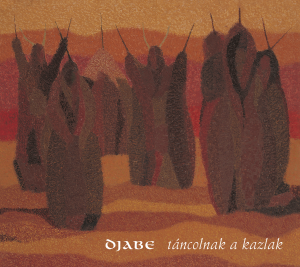
The making of the album ‘Sheafs are Dancing’ was inspired by the paintings of Imre Égerházi. In terms of editing method, one painting – one composition. Pieces are subscribed to Tamás Barabás and Attila Égerházi, with the addition of Ferenc Kovács and Zoltán Kovács in case of a few tracks. The album was the most successful release of the time by Djabe, and raised many heads in the professional scene across the world. It was the beginning of international success for the band. The album was nominated for MAHASZ Award in ‘best world music recording’ category in 2003. The disc itself is contained in a hard-case book of the paintings, hence the listener can enjoy the visual while playing the album. It was the first Djabe album to feature Steve Hackett, a beginning for many future releases and joint tours. His acceptance of Égerházi’s offer was more of a personal decision: Steve is quite fond of the art of painting, because of his father, and ex-wife. The next step was the release of the album’s new surround version where paintings could be enjoyed on the screen, too. This was the first DVD-Audio release of Djabe, and the first Hungarian release of this kind. The release was praised even by the audio engineers of Abbey Road where the auth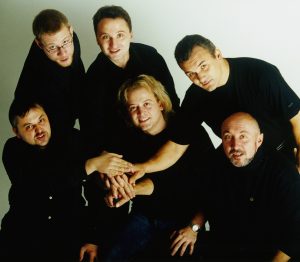 oring process taken place. It even received a PRince Award for ‘best multimedia release’ – not without a reason as the visual content consisted of not only paintings, but nearly a 100 creations and documentary videos of Imre Égerházi, including an animation clip of his near-death experience-inspired work ‘Iceworld’ and 6 other paintings, connected to it. The base for this unique experience was the painter’s own near-death experiences, his interview can be listened to as an audio commentary for the aforementioned ani
oring process taken place. It even received a PRince Award for ‘best multimedia release’ – not without a reason as the visual content consisted of not only paintings, but nearly a 100 creations and documentary videos of Imre Égerházi, including an animation clip of his near-death experience-inspired work ‘Iceworld’ and 6 other paintings, connected to it. The base for this unique experience was the painter’s own near-death experiences, his interview can be listened to as an audio commentary for the aforementioned ani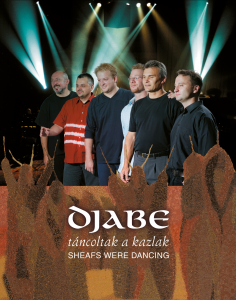 mation clip. Furthermore, a partial video of the album premiere tour and a road movie is also included on the disc. The extra content was praised even in Los Angeles, and nominated for Surround Music Award in ‘extra content’ category. The multimedia experience was further developed along the premier tour, both video and audio wise. Music in surround not only existed in studio version but gigs were also presented in 5.1 sound. The band again returned to using background projections to show the title paintings, and other connecting creations and videos by Imre Égerházi which inspired the paintings. The gig started with a biography film about Imre Égerházi. This exemplary cross-art span was concluded in a gig at New Orleans Club, Budapest, Hungary in January 2004. The room next to the concert hall housed an exhibition of the paintings featured on the album. The visually augmented experience was followed by an unplugged version of the album. The 2-year long multimedia tour spawned the double-DVD album ‘Sheafs were dancing’, featuring multiple openings for Imre Égerházi expos, as Djabe performed regularly after 2004, the success of the unplugged concert. In 2016 the album was re-released with hard cover matching the original but featuring a double-CD format, with an extra concert disc. The release featured the title in English, an effect of the growing international success. The backbone of the content was the Tour 2003 Budapest material. One of the videos is from 2004, featuring saxophonist Viktor Tóth as band member and was recorded in the New Orleans Club. The last recording on the disc shows the 2015 joint concert with the Miskolc Symphonic Orchestra, performing together in the Bartók Béla National Concert Hall of Müpa. Djabe’s longtime dream came through with the birth of symphonic versions of ‘Flying’ and ‘Iceworld’.
mation clip. Furthermore, a partial video of the album premiere tour and a road movie is also included on the disc. The extra content was praised even in Los Angeles, and nominated for Surround Music Award in ‘extra content’ category. The multimedia experience was further developed along the premier tour, both video and audio wise. Music in surround not only existed in studio version but gigs were also presented in 5.1 sound. The band again returned to using background projections to show the title paintings, and other connecting creations and videos by Imre Égerházi which inspired the paintings. The gig started with a biography film about Imre Égerházi. This exemplary cross-art span was concluded in a gig at New Orleans Club, Budapest, Hungary in January 2004. The room next to the concert hall housed an exhibition of the paintings featured on the album. The visually augmented experience was followed by an unplugged version of the album. The 2-year long multimedia tour spawned the double-DVD album ‘Sheafs were dancing’, featuring multiple openings for Imre Égerházi expos, as Djabe performed regularly after 2004, the success of the unplugged concert. In 2016 the album was re-released with hard cover matching the original but featuring a double-CD format, with an extra concert disc. The release featured the title in English, an effect of the growing international success. The backbone of the content was the Tour 2003 Budapest material. One of the videos is from 2004, featuring saxophonist Viktor Tóth as band member and was recorded in the New Orleans Club. The last recording on the disc shows the 2015 joint concert with the Miskolc Symphonic Orchestra, performing together in the Bartók Béla National Concert Hall of Müpa. Djabe’s longtime dream came through with the birth of symphonic versions of ‘Flying’ and ‘Iceworld’.
Portion from the book ‘Djabe – 20 years in sounds of freedom’ by László N. Göbölyös
Paintings of an exhibition – a cliché enough title, and we would already have made a mess of it all. Not just because it’s already taken in cases of music and fine arts. Think about the works Mussorgsky, Ravel, Emerson, Tomita, but more to the point: the example of the 19th Century. Mixture of music and painting resulted in the music being the one to remembered. A period inspired by Viktor Hartmann (1834-1873), majority of the paintings of his lost to us. The oeuvre of Imre Égerházi (1925-2001), however, is still with us, with the son of his as a faithful guardian, and Djabe’s music as a re-interpretation. For the loss of a father, ensuring his life’s work is the best remedy of all. Like continuing his paintings, but instead of a brush with the use of sounds, musical instruments – and as we are talking about Djabe, besides the catalogue book of the album, the visual experience at live gigs are also part of this mix. For one, they turned the standard of video clip making around and tailored the music to the visual. After composing the paintings are added to this finished musical experience, the linked associations, document movie parts. In Attila’s opinion, the presence of the artist does not overpower the band but added something to expand the music. The parallels between paintings and music are presented on a silver plate, with fine tinges and seemingly static movements. It can be said that the ‘Sheafs’ is one of our days’ most beautiful impressionist music. Imre Égerházi took at least a little from impressionist air. Even the title track of the album shows a finesse of harmony as sheaves are truly human. I first met with the Master almost a decade after my first listening to Djabe’s album. In 2014, an exhibition was held in the aula of the Ministry for Foreign Affairs. Titled ‘Over our borders in the eyes of Imre Égerházi’, I could experience some paintings I already listened to. Even if Imre Égerházi used multiple techniques, for me the feeling of Djabe music was presented by paintings (or the other way around, but whatever) where wood fiber and oil paint meets in a unique, granulous impression. Examples are the ‘Thiérachei emlék’ or one of the variations of ‘Lengyelország felett’ (as Miklós Radnóti said ‘For one who flies above, this land is merely a map’ – this motif surfaces often), and as feelings met in the music from Northern France and Pannonian Basin to the Balkan, these painted pilgrimages melting into one coherent whole. The ‘Fátyol mögött’ literally looking into the eye of the beholder, through giant eyes of a woman and windows in the background. This has a musical imprint on ‘Sheafs’: affable (through the trumpet of Feri) but keeping its secrets. As a great lover of Italy, the two paintings of ‘Olasz táj’ said great many things to me: one red with sun and the other of early autumn, just like I seen on the train blazing through Toscana one year earlier. The Bulgarian paintings talked to me almost in the same way: ‘Sumeni táj’ and ‘Naplement’ (titled ‘Alkony a tengerparton’ on the album) – these paintings, seemingly without any human presence, showed me sleeping, resting and watching figures. Imre Égerházi loved the music of Djabe, and painted often while listening to it. “Now we turned the angle of inspiration around, and started to compose, effected by his paintings.” – said Attila in an interview for Gramofon. “I was too surprised of Tomi’s almost Bartók-like sensitivity for musically representing the feeling of paintings like ‘Téli Hortobágy’ or ‘Szemrehányás’. We had a challenge composing for paintings of the Great Plains, Hortobágy and Transylvanian or Carpathian Ruthenian scenery, as previously we operated with African, Arab, Indonesian and South-American effects.” The numerous Hungarian motifs, presented mostly by Feri’s rustic baroque violin play, can be very well acquainted to an Indian tabla played by Péter Szalai and a soprano saxophone by Ben Castle in the ‘Hajdúböszörményi utcarész’ – for Djabe it’s not a contradiction. As Attila said, if it must be explained, this is a way to “summon the taragot”. But no explanation needed for the presence of Steve Hackett who sounds his guitars in ‘Thiérache-i emlék’. A member of the band Genesis, a musician often associated with Djabe, is a universal talent who quickly finds his place in any new environment. “Djabe made me display an extreme musical and emotional reaction, and I think this is the point. To give an emotional charge to music even touching not just the audience but the musicians, too, resulting in a cathartic experience.” – said the band leader about Steve. Even if the album was inspired by a sudden loss, it’s not about the grief but the beauty of a legacy left behind. As one of the most emotional piece, ‘Iceworld’, before which we can hear the Master as an opening, reflecting on his near-death experiences as a commentary for the painting ‘Repülés’: “As I arrived, there was only ice. In the foreground in a pile of ice, seemingly standing, some people, but not standing staticly but moving with their own space of ice… way back objects of unknown form growing out of recesses, alive… one eye closing, another opening… way more back buildings of unknown geometry I never seen before, I draw them multiple times to give back my experience… maybe to be solved one day.” These things, seen by Imre Égerházi half-way, not only spawned a vision of sound, intensive even with its own inner peace, of trumpet, acoustic guitar and bass guitar but a video clip to literally bring life to the lines of the blue painting. At the beginning and end of the movie, moments of the life of the Painter is sweeping through like in a photo album, like a dying man’s last breath. In a conversation titled ‘Musicians of an exhibition’, Feri said that the sorrow in the music is not real pain, but the experience of understanding, the urge of understanding deeper meaning. Tomi told that at a exhibition in Debrecen, when playing the video for ‘Iceworld’, a young man stepped to him and ask what is this about? After Tomi telling about the background of the origin the young man confessed he had near-death experiences too, and the video showed exactly how he felt. But we can’t just walk by such pieces like ‘Szemrehányás’ and ‘Beszélgetők’. The two woman on the first, probably a mother and daughter, are felt not only feeling reproach towards each other, but – while the violin talking back increasingly to the ostinato main theme – resistance till desperation. The other, originally titled ‘Utcarész’, has two characters barely visible, and Zoltán Kovács’s piano solo truly represents a stillness of air in a village where even the smallest of happenings is a thing of awe and be talked about. Father and son finally take each other’s hand in the album’s last piece, ‘Virágcsendélet’, composed for acoustic guitar. We now know that this was Attila’s first composition, bloomed in the art studio of his childhood. The main motif of daydreaming often reoccurs on guitar, as a bass solo and with the vocal of Judit Herczeg. A composition is completed, a life is completed, and everything goes on. Tomi, in the interview quoted, remembers that this work was needed to strengthen the connections between band members. “There are some moments in life when one becomes older, wiser and more experienced, and this was such a moment in the band’s life” – Attila added. “In Hungary, you can listen to music that is just like the Hungarian reality. It includes our material reality but as a cleaner version” – said Sipi. “The album is very well composed, the most complex work to day, and this made apparent that the emphasis will shift around the band according to the wishes of the music but I found my place just perfect” – he pointed out. “Stern and easy, intellectual music is played by this band, broadened to six members (their compositions sometimes so movie score-like we see pictures appearing on the horizon of our imagination). ‘Sheafs are dancing’ brings even more than the success before (Ly-O-lay Ale Loya, Witchi Tai To, Update). The freshest about it is a Gesamtkunstwerk experiment: this time the marriage of visual arts and music is explored” – wrote János Csontos in the journal Magyar Nemzet, about the album. “The idea is not unknown, but the choosing of the painter makes it so: Imre Égerházi (1925-2001) was unequivocally classified as the member of the Great Plains school of painters, and this cage – even if he was pushing the envelope – could not be broken until his death. He remained faithful to Hajdúság and Hortobágy while painting the Transylvanian hills and the seaside – true, a bit like snowy mountains looking down on the Great Church, or the sea billowing at the edge of Böszörmény. The painter, who tried fusing tradition and modernism, embraced a mystic side when painting his near-death experiences: these canvases hold more than clichés and things indescribable with words, reporting from the border that waits for all of us. Attila Égerházi, one of the painter’s sons, is the band leader of Djabe. This album is in fact a salutation of a son before the legacy of a father. Luckily is not just visual art put to music: according to the catalogue of pictures of paintings included with the album is more of a re-imagining born by inspiration. ‘Beszélgetők’ and ‘Gyimesi hegyek’ are different kinds of successes; in the opus titled ‘Hóvihar’ an authentic folk-song can be heard behind the veil of music, and in ‘Iceworld’ Imre Égerházi’s monologue about the topography of his near-death experience is presented as a mental firmament besides the music. Everything is painted on a canvas so we must believe him. This (after) world is of tones grey, white and blue, its icemen and ice flora are alive and moving. Maybe we need to refuse the vision about a death described with warm colors?” Co-performance with a globally known celebrity (I would not like to call Steve a ‘pop-star’…) is a great testimonial for any band on the international waters. The movimentoprog.it, quoted earlier, starts with his critique about ‘Sheafs are dancing’ with an appreciation for Attila’s organization work of the Hackett-concert in Budapest, mentioning the agreement between Camino and Gramy about the distributing of the British musicians’ albums, and finally, the guest-starring of Steve on Djabe’s album.
“One of the pearls of 2003” – wrote the Italian critic, and after recognizing the influence of Pat Metheny and numerous progressive band of the ‘70s, he adds: “The whole album is transpierced by some unique intellectuality. An undefinable atmosphere known to people visiting Easter-European capitals like Prague or Budapest. Best example is ‘Téli Hortobágy’ where world music, folk and fusion are living together in harmony… The inspiration for the album also makes it unique. Imre Égerházi is a well-known and respected Hungarian painter, the father of Attila, passed away in 2001: he often got his inspiration from listening to Djabe. This time, the band pays its respect to an exceptional visual artist by getting inspiration from his paintings. The catalogue book, included with the album, is extraordinary: all the 15 paintings, a real clean source for the musicians thirsty for inspiration. The pretty scenery of ‘Tájak’ and ‘Fátyol mögött’, the beautiful, confusing ‘Szemrehányás’ of great finesse. The ‘Gyimesi hegyek’ is a folk-episode governed by the violin of Ferenc Kovács. And ‘Virágcsendélet’ is on a similar track…
…The full-bodied rhythmic section of András Sipos and Szilárd Banai (the critic obviously was oblivious of the Hungarian meaning of the drummer’s name – the author) serves as a charming amalgam between the violin and the trumpet (Ferenc Kovács). Jazz-tones are rich, thanks to Zoltán Kovács and the virtuoso bass player Tamás Barabás. Tamás’s sensual slap is often re-surfaces. Attila’s acoustic guitar embraces, Ben Caste’s enviable knowledge enrichens the music” – wrote the Italian critic, who called the ‘Triéache-i emlék’ by Steve “a luring bit of new age/soft rock”, the ‘Flying’ and ‘Iceworld’ a “ice-cold imagination between life and death”. The fusion of music and visual art, the sounds and visuals into one experience, a thing accustomed to Djabe before, paired with the guarding of the legacy of a father, resulting in a series of events and releases. ‘Sheafs are dancing’ is a paramount for Djabe to day – or it would be, Attila warns, as Djabe has no paramount and possibly never will have one. They aspire not upwards but forward, on ever widening roads, often hiding rifts and traps, but nothing can compel them to turn back.
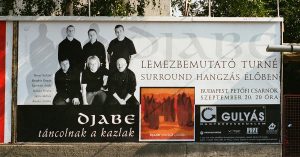
Sheafs are dancing Tour
In the meaning of the word, the band done everything that can be as a creative artistic community.
“The material has been selected and edited with the utmost care. The visual fits perfectly into the music and sounding. Does not defer your attention, supplements the pieces well, or should we say, made one coherent whole with it. Seeing nowadays’ austere video clips this visual and audio effect almost means a dream come true…” – wrote a rapturous Attila Kiss in Stereo Magazine after the concert in Pecsa.
“…If the evening of 20th September should be defined I would say something about a Gesamtkunstwerk to best describe the experience. Besides music – hiding archive recordings even – paintings, pictures, movies appear. I may compare it to something experienced at a classic opera. But for me it means even more as this representation of the genre, defined as light music, should be among classics. Experiences, emotions, memories captured in music, with a good amount of creativity, the best and most of today’s technology and with maximalist execution, resulting in something unparalleled…
…Nearing the end of the performance I thought Djabe not only pays respect to, not only commemorates Imre Égerházi. This concert was more than that. Paintings re-defined by Djabe pieces, and the audience felt that while not painting with a brush but a guitar, Attila Égerházi stepped in the footprints of his father, with the same intellectuality. Seeds, fallen from the Sheafs dancing, spawned new life that evening…”
This concert is in the core of the 2006 double DVD release ‘Sheafs were dancing’, on which we can all see the performance again, made whole by moving paintings and video recordings, and opens with a video portrait of Imre Égerházi from materials of interviews and a news report, and finishes with a Djabe best of show. Exceptionally interesting is the folk video d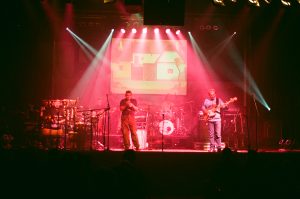 ocumentary complementing the painting ‘Gyimesi hegyek’, shot by Imre Égerházi and László János Nagy in 1972, at the first Csango Festival in Gyimes. Montage of ‘Szemrehányás’ also raises eyebrows, in which appears the artist’s village of birth, the rustic atmosphere of Hajdúhadház and Imre Égerházi’s mother and siblings. The backbone of the video was hand-picked by Attila from the 8mm material shot by László János Nagy introducing Imre Égerházi, in 1973. Other material mainly includes Super8 recordings shot by his father; these were used as visual background for the concerts. It was meant to help the audience understand the creations better, as the materials included were mainly shot at the place of inspiration for the paintings or while traveling. Imre Égerházi composed well not only on wood fiber canvas but with a camera, too. Projections show creations like the painting in question, expanding the horizons of the visual artistic theme. The Iceworld-clip, with a screenplay made by Attila from Imre Égerházi’s near-death experience, was made by the professional animation team of Focus-Fox Vide Studio based on the 9 paintings inspired by the master’s state of clinical death. A paramount for the
ocumentary complementing the painting ‘Gyimesi hegyek’, shot by Imre Égerházi and László János Nagy in 1972, at the first Csango Festival in Gyimes. Montage of ‘Szemrehányás’ also raises eyebrows, in which appears the artist’s village of birth, the rustic atmosphere of Hajdúhadház and Imre Égerházi’s mother and siblings. The backbone of the video was hand-picked by Attila from the 8mm material shot by László János Nagy introducing Imre Égerházi, in 1973. Other material mainly includes Super8 recordings shot by his father; these were used as visual background for the concerts. It was meant to help the audience understand the creations better, as the materials included were mainly shot at the place of inspiration for the paintings or while traveling. Imre Égerházi composed well not only on wood fiber canvas but with a camera, too. Projections show creations like the painting in question, expanding the horizons of the visual artistic theme. The Iceworld-clip, with a screenplay made by Attila from Imre Égerházi’s near-death experience, was made by the professional animation team of Focus-Fox Vide Studio based on the 9 paintings inspired by the master’s state of clinical death. A paramount for the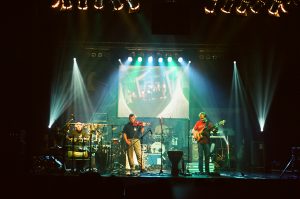 performance was the perfectly timed live musical score. Permanence, tranquility, serenity, balance – these are the Artist’s professions of faith, these emotions must flow towards the audience and this is what is suggested by the complex pieces of ‘Sheafs’. With this performance Djabe toured around Hungary and neighboring countries – emphasis put on live surround sound on the posters. A good representation for the tour’s spirit that in October, the Corso restaurant in Sopron even made a special, unique menu called ‘What Sheafs are dancing to’ in honor of the band.
performance was the perfectly timed live musical score. Permanence, tranquility, serenity, balance – these are the Artist’s professions of faith, these emotions must flow towards the audience and this is what is suggested by the complex pieces of ‘Sheafs’. With this performance Djabe toured around Hungary and neighboring countries – emphasis put on live surround sound on the posters. A good representation for the tour’s spirit that in October, the Corso restaurant in Sopron even made a special, unique menu called ‘What Sheafs are dancing to’ in honor of the band.
“Djabe consist of exceptional musicians, who are capable to create greatness in many styles. With sounding as colorful as our surrounding world. Without borders. While listening to it, the spirit and intellect can roam free. Be a painting or a rhythm thumped on an African drum, a sound on a piano, an accord of a guitar. Djabe achieves what is one of their dedicated goal: the freedom of spirit” – written in Veszprém Megyei Napló.
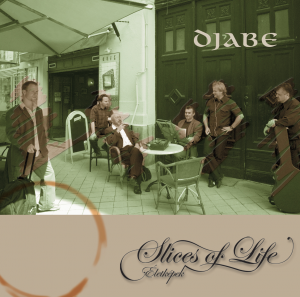
In 2004 Djabe irrevocably became a global phenomenon. At the Kaunas Jazzfest they were headliners with Randy Brecker, Roy Hargrove and Earth Wind and Fire Experience. This was followed by the Rochester International Jazz Fest and Washington, USA in the summer, then the first joint concert with Steve Hackett, in London. The end of the year found them in Sarajevo, Bosnia-Hercegovina. In 2005 they performed at Burghausen Jazzwoche and the gig was aired globally by BB Alpha TV. Djabe went to the Stockholm and Pori Jazz Festivals and the world-famous Czech Jazz Goes to Town event. Over the Atlantic it was once again Baltimore and Washington, in the latter attending in the famous Blues Alley. In the summer the band performed in Bulgaria the first time. In the autumn they were called back to Munich and Regensburg, Germany. In 2006 the Polish and Italian audience finally had the chance to meet Djabe, and they returned in the USA, Czech Republic, Slovakia, Croatia, Lithuania, Finland and performed in Berlin, Germany. Viktor Tóth (alt saxophone) became a full member of the band in 2004 and helped build the fame of Djabe till summer 2005 when instead of himself he sent only a message to the recording of Slices of Life saying he is quitting (despite the album was composed with the saxophone in mind being a major element). Members decided against recomposing and asked their friend and fellow musician Ben Castle to record the saxophone for them. Ben did a splendid job, but with his schedule it was impossible to perform live with him. During the composing of this album Tamás Barabás and Attila Égerházi took the experiences of international tours and festival appearances into consideration. They felt these large-audience, often outdoor events need something with a faster tempo, with more momentum. In this spirit Omachule, Doromb, Hajsza a Ménes után, Indian Experience and City of Habi were born.
Slices of Life released in CD and surround DVD format, the latter with a 50-min concert film recorded in New Orleans Club featuring Viktor Tóth in 2004 (a rare video material with him performing while his somewhat brief membership). The album also released in Thailand by HITMAN Records (Bangkok) in 2010.
Portion from the book ‘Djabe – 20 years in sounds of freedom’ by László N. Göbölyös
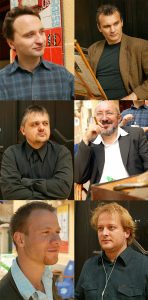
The Hungarian title (Életképek, in English “Life pictures”) implies that the visual experience is still the determinative element with Djabe and themselves marketed this album as a sequel to Kazlak, the English title paints a bit sharper image than the pastel colors of the last release. One thing is sure, the band (strengthened by Ben Castle on saxophone) has no shortage in witty solutions and unexpected shifts. Of course, we know the quality of a piece is in no way related to the length of it but surely, we should notice that all tracks are 7 minutes or longer (with the exception of the closer Night in Kolkata). Examine the opening Doromb where the ancient metallic instrument gets a part. The deeply vibrating and resonating sound shifts (with the needed rhythm-support) into a somewhat Mexican trumpet-saxophone duo while Ferenc Kovács smuggles his verbunkos with Zoltán Kovács not far behind with a piano rush, Sipi giving out ecstatic sounds and there’s a cacophonic part that is only comparable to Mothers of Invention from 1967-68. Wondering that it was a big hit?
Message from Iceworld connects to the Iceworld of Kazlak with its opening, its like hearing the sounds of the first lines of the Hungarian National Anthem but following this ethereal opening and the percussion a multi-player ice dance ensures, punctuated with fortissimo jumps. Sigh is rather philosophic with the re-return of the main movement and the partial drum solo and the answer to this philosophic question is in the closer allegro. And another hungaro-cubano and another hit, Omachulé. Not only Sipi mixes things up without end but all members are doing their best in this most joyful piece about connecting the Great Hungarian Plain with the Caribbean. Rush for Ménes is about contrast between the peace of said plains and horses broken free in a thunderstorm. Waterfall is about the natural beauty and sparkle of a waterfall without recreating nature sounds or a rushing column of water. The title piece Slices of Life is a joy-music born from lyre while City of Habi takes us into a fairy world and with its simple base reminds us of the Djabe song with solos of Feri and Ben showing us not equatorial Africa but the gates of an oasis, seen from the sunburnt desert. Children’s Room features a kid orchestra in it and as inordinate and lovable like a real child’s room. Indian Experience summoning India is only a pretense, the real surprise is the entry of Echo quartet’s miniature string quartet at the end, gently leading us to the closing piece.
Djabe once again had no problems with critics. This is from the pen of Katalin Farkas (Magyar Rádió): “When the band sent me this latest album, I knew I’ll be in for another great musical experience and they delivered! I liked the colorful Slices of Life, the exceptional and innovative arrangement and above all the perfect virtuoso solos, the intoxicating pulsation all reminiscent of older compositions but with jazz elements much more mature and expressive, stepping out from the world of Pannonian Basin folk music and moving towards rich and colorful motifs. Congratulations!”
Criticism of Péter Héty (Tájoló): “When I recommended the band’s very fist album to the jazz music editor of Magyar Rádió they backed out saying it’s not jazzy enough. This concern is no more as starting from the early World music sounding Djabe plays mature and unique jazz now. Featuring numerous sub-genre characteristics from softer to fusion Jazz-Rock, sometimes in the same composition but without becoming eclectic. Meanwhile it is still easy on the ears and rich in melody, all in the good sense of course. Compared to earlier works the Afro-Latin sounding of András Sipos takes a back seat while Tamás Barabás, one of Hungary’s best bass guitarist, gets more ‘Eastern’ tasks and the rhythm section of precise drummer Szilárd Banai receives more spotlight, just like the winds by Ferenc Kovács and the talented young Englishman Ben Castle. An interesting closing motif is the short string quartet arranged by Tamás Barabás. Sounding is a first-rate audiophile experience and much more complex than before, sometimes becoming quite symphonic. The knowledge of these experienced musicians is paired with being well-equipped considering both technical and instrumental elements. This album’s real virtue is that it can be enjoyed by both audiophiles and those who only want something entertaining to listen to.
The opinion of Bu-Jazz (Exit Magazin): “The last album of Djabe, Sheafs Are Dancing, is a memorable bit of the Hungarian musical scene. Combining World music with Jazz with clear and articulate results, Djabe’s new album (almost completely composed by Tamás Barabás, the bass guitarist of the band) is likely to receive even more praise. Featuring saxophone player Ben Castle (he is also on the last two albums) this is a logical sequel to the album before. It is more dynamic, more sweeping with the virtuoso play and the pronounced solos. However, it is still very admissible, so the success is even more prominent than before. Djabe once again elegantly widen its borders and became unavoidable in its own class.”
This writing from Pannon Jazz in January 2006 is not even just a criticism of the album but tried to put this newest work in context with the band’s career so far: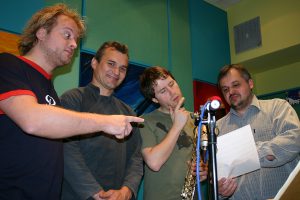
“When the fist Djabe album with no separate title got released in 1996 this band was one of many promising jazz bands here in Hungary. The following years ever better albums of both musical and technical quality released while we had a grasp of organizing and management skills too watching them at gigs. These skills are not generally possessed by jazz musicians (or civilians) the results of the band’s unfolding are becoming quite clear. The press nowadays is loud from Djabe’s international success and evidences of this success are released in the form of albums. Don’t get me wrong, I’m not yet talking about Slices of Life but the Goes to Festivals released in 2005 featuring recordings of gigs from USA, Pori and Stockholm. This is not just some promise! The material features two more tracks: a preview for Slices of Life. The advert succeeded, at least with me as I eagerly awaited the new release, especially the piece Doromb by Tamás Barabás (this became the opening for Slices). I maybe using words a bit too large but in this piece, there is really a compilation of a 1000 years of musical history. The purring sounds at the beginning summon something from ancient times mixed with so much momentum it could envied even by Vágtázó Halottkémek. In the interesting jumpers some verbunkos-like elements are mixed into, somewhat referencing the Hungarian Reform Era. At the end of the composition the saxophonist Ben Castle injects mainstream jazz mood with his solo. The continuations are some pulsating lyres but there is still much more. Omachulé gives the opportunity for András Sipos to be the center of attention with his vocalization and jocularity, and deservingly so, just like the solo of Tamás Barabás. Hajsza a ménes után shows us what would it be like if Al Di Meola born as a Hungarian as I’m sure he would have written something like this not Race With Devil on Spanish Highway. In a way Attila Égerházi worked with this instead of him! After the trickling Waterfall comes a slowdown with the title piece, but blows us away nonetheless, not letting us go for 4 more tracks. The exotic and mystical City of Habi is contrasted by the peaceful fuss of Children’s Room. Images of far away lands summoned by Indian Experience through the thoughts and consciousness of real European musicians. Night in Kolkata prepares us for saying goodbye but not by Djabe but the string quartet of ladies, the Echo Quartet. Music ends after almost 80 minutes, but the experience lingers on. The world-jazz fusion genre (defined by Ben Castle) here shifts towards jazz but without harming the connection to the other. But the most important thing: Djabe discography just got enriched with something really valuable!”
As it can be expected, the CD of Slices of Life was only the first to be released. Only 3 months later (February 2006) came the 5.1 surround DVD with the aforementioned New Orleans Club video material, a live TV recording of Hajdúböszörményi utcarész and a travel journey from 2005 about the gigs in Pori and Stockholm. The latter was found reaching beyond the current material by Sándor Olasz (Rockinform): “Not just because only a handful of Hungarians get to travel to these places, so it is fundamentally interesting. More so because it indicates how much interest (pretty much) can an unknown band gather up North.”
Slices of Life tour
The album was once again premiered with a great tour. The complete album material was played at the gigs, with only 3 acoustic pieces added from other albums (Venezia from the first Djabe CD, Virágcsendélet and the second movement of Tájak titled Alkony a tengerparton from Sheafs Are Dancing; the encore was also chosen from this album: Fátyol mögött). Considering visuals all pieces got different identity. Once again, the top-quality intelligent lighting was the base for the stage presence. Projector and surround were absent this time. At this tour the habit of asking a member of the audience to join the band on stage to play the angklung became a tradition. On the international part of the tour more compositions were added but still, the Slices of Life remained the main attraction of the gigs.
 Many foreign critics wrote praises about Djabe. This is from Jeff Spevak (Rochester, 2004):
Many foreign critics wrote praises about Djabe. This is from Jeff Spevak (Rochester, 2004):
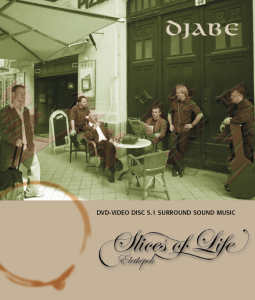
How does Hungarian jazz sound like? Get a light-hearted jazz played by 7 guys looking like van drivers and shower them in paprika. Spice it up with Eastern Europe folk sensitivity and of course a Hungarian violin. The audience of the main tent just soaked it all up.”
When returning to Rochester in 2006 a summary was published by Rochester Democrat and Chronicle: “Like a Buster Pindexter goulash the roots and retro profanity of traditional Hungarian music takes a real jazzy slap in the face from Djabe with the genius bass play by lead composer Tamás Barabás and the Hungarian 6-member team around him. Their polyrhythmic play gets more momentum from brass instruments and has a potential to crash but in the end, it dances on both legs. In any genre or groove. Unexpected, unique and entertaining.”
The tour was released multiple times. Best moments of both local and foreign got pieced together on the double CDs of Message from the Road. The second disc was a dual disc with the DVD side featuring the complete concert material in 5.1 and a 1-hour film made mainly from foreign TV recordings of the gigs. The added media book shows us the atmosphere of said gigs. The 2006 PeCsa performance became a DVD release titled Slices if Live, but work got protracted by the sad and untimely passing of András Sipos in 2007: the album only made it to the stores in 2012. Besides the concert film there are many extras on it.
 “Djabe plan to continue the work even harder in 2008. We’ll finish Take On. Official release date for the CD is the 18th of February. DVD-Audio with extras will be released on the 27th of March. With the new album a tour will commence in 2008, through Europe, North America and Asia. Djabe will continue as a quintet, as position of the irreplaceable András Sipos will not be filled” – stated by a press release of the band.
“Djabe plan to continue the work even harder in 2008. We’ll finish Take On. Official release date for the CD is the 18th of February. DVD-Audio with extras will be released on the 27th of March. With the new album a tour will commence in 2008, through Europe, North America and Asia. Djabe will continue as a quintet, as position of the irreplaceable András Sipos will not be filled” – stated by a press release of the band.
Take On has the touch of András Sipos all over it, literally. All the percussion parts were played by him and vocals were recorded with only 3 exemptions. This unparalleled momentum surfaces in the opening Take On and later an amalgam of African rhythms, the violin of Öcsi and the tar of Malik Mansurov can be heard in Kilinama. This unison is quite peculiar: Steve is right to compare Malik to John McLaughlin. This duo makes the audience remember MacLaughlin and Jerry Goodman performing in the Mahavishnu Orchestra.
Then And Now has something timeless about it, mostly because of the piano and the saxophone play of John Nugent. This is the first time of the American musician and manager of Rochester Festival as a guest star, who also introduced Djabe overseas. The same can be felt in Attila’s short, meditative solo, but the duo of Tomi and Szilu pauses the piece like a crossroad. The Latino-like Butterfly summons bands of the 60s, like Herb Alpert’s Tijuana Brass and Sergio Mendes’ Brasil ’66, in its main theme, as Feri knows even this kind of trumpet play method. At Night, nomen est omen, starts with a dreamlike trumpet but speeds up by Sipi, Tomi and Ko. Dreams can change rhythms, too, sometimes so disturbingly we even wake up from them! And another Latino-like, but different from the others: Los Sipos, a song to remember the Percussionist, played by himself. But even without him, this piece cannot be absent from the Djabe repertoire. Loose, easy, playful, dynamic and filled with joy – like the Sipi we remember.
Crazy Morning is rushing, flustering and short, with solos unfinishing, maybe only John gets some space. Opening sounds of Afro Dance could come from Graceland of Paul Simon (sorry for the numerous similes but musical parallels meet not in the infinite but in ourselves). Of course it changes all over again with vertigos of Ko and the again-guest starring Ben Castle, and at the end Attila’s electronic guitar widens the horizon of seeable sounds. Wind and Bells only have piano runs for disturbance, but where did this Indian drum imitation came from, followed by a funky saxophone and gypsy music that makes you want to dance? Sándor Budai and his band delivered as expected… the album’s most complex, surprising piece, my personal favorite! The African and Hungarian musical unison gets a great example in Sárika, with characteristic Sipi-vocals and a tone stretched till the Carpathians by Öcsi. End Of A Beautiful Day couldn’t be any other place than at the end of the album. The last (?) piece with Sipi, an end of an era. I imagine a video clip: Sipi steps out from the studio in Ráday street, walks along the street, looking back once more and says something, with unruly eyes, then continues his walk to the tram stop, camera gains distance and his figure fades away…
The album soon released in double side DVD, the video side sporting a 50-min recording of Sipi’s last gig, in Debrecen, Hungary at 7th of September, 2007. This makes the passing and the rite of remembrance complete.
“Even after the tragic loss, Djabe is stronger then ever. A proof of this is the charity and memorial concert for Sipi, made real by the band and Steve Hackett. Or the freshness and power of the album Take On. The new CD is a worthy successor for the band’s traditions, the represented musical value of theirs. The composing skills of Tamás Barabás integrate the knowledge of all the band members, resulting a new level of quality. Compositions are fresh, unique but nonetheless familiar. World music from Hungary and Azerbaijan, with jazz by multiple approach. Gigs are for showing this in full for the audience” – a Djabe revival-review by hzo.hu site.
Another fairly positive review was concluded by the Slovenian critic Rok Podgrajšek, giving 8/10 for Take On.
“You don’t hear the name of Djabe exactly mentioned on every street corner, or even at jazz or progressive rock gatherings. Djabe have sort of become lost within the boundaries of progressive rock, jazz and world music. They belong to each of these genres and to none of them. Their music surpasses simple genre definitions, which is a great credit to their music, but it also means that it hasn’t really found a niche. Recently, Djabe have been hit with a great tragedy with the loss of their singer and percussionist Sipos András, also known as Sipi. Take on features the last recordings Sipi ever made with the band. The album also includes a composition dedicated to Sipi, with the Genesis-influenced title of Los Sipos. This album has everyone that is great about Djabe, including an excellent live performance at the Debrecen Jazz Days. Djabe have a recognisable sound and it’s hard to mistake them for anyone else, but still every album is nothing like the rest. Because Djabe are not restricted by genre definitions and any other restrictions, they can just about use any combination of influences at any given moment. This gives them plenty of room to build and they make good use of it. While their main idiom of expression is almost always jazz (on this record as well), they always find ingenious ways to incorporate other musical elements, even when you would least expect them. Thus we hear plenty of world music influences, Latin music (Los Sipos), Romani (gypsy) music, folk, rock and occasionally even classical. It may sound chaotic, but actually Djabe make the music flow like a river and with a resounding musical quality to touch the deepest recesses of your heart. Their music is not only full of intelligent twists and turns, but also so full of feeling. You can truly feel their love for their music and it is reflected in the composition.”
Podgrajšek also praised the idea of a double-sided DVD. He liked the idea not just because it is a respectful way to remember Sipi:
“However, this was the last live performance of Sipi with the band, a week before his death and the band felt that under the circumstances it had to be released. It is a good choice because on one album you get the last Djabe studio album as well as a live performance, where Djabe are arguably at their best. Their free compositions are given even more freedom and room to manoeuver. Djabe are a very relaxed band with a fondness for performing and this can definitely be seen in this show as well.”
Sorry, this chapter is only available in hungarian.
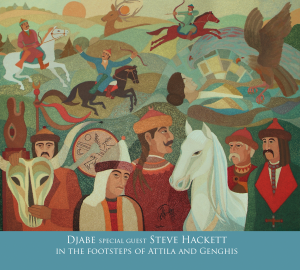 For Djabe 2010 started in Sarajevo, followed by Madrid and Thailand In August, the formation ‘Djabe special guest Steve Hackett’ started an Eastern Europe tour in Kaliningrad, Russia and Budapest, Hungary (the latter was the Djabe 15 extra gig). The tour continued in Debrecen and Pécs, Hungary, then travelled to Wien and Sofia and went to the Bansko Festival. After the Serbian Nisville Jazz Festival the tour ended in Belgrade. All the Hungarian gigs were recorded and released later on double CD; the first disc takes its material from the Debrecen show, the second from Pécs. Besides audio, concert video clips also made it to the discs: on the first a Serbian TV material from Nisville, the second shows portions of the Malaysian concert.
For Djabe 2010 started in Sarajevo, followed by Madrid and Thailand In August, the formation ‘Djabe special guest Steve Hackett’ started an Eastern Europe tour in Kaliningrad, Russia and Budapest, Hungary (the latter was the Djabe 15 extra gig). The tour continued in Debrecen and Pécs, Hungary, then travelled to Wien and Sofia and went to the Bansko Festival. After the Serbian Nisville Jazz Festival the tour ended in Belgrade. All the Hungarian gigs were recorded and released later on double CD; the first disc takes its material from the Debrecen show, the second from Pécs. Besides audio, concert video clips also made it to the discs: on the first a Serbian TV material from Nisville, the second shows portions of the Malaysian concert.
Critique of János Gregorits, a critic for JazzMa:
„This double album sports the recordings of a tour from Russia to Bulgaria. Djabe invited Steve Hackett (legendary guitarist for Genesis), who wrote a tour blog for the album (I never known Vladimir Vysotsky, a Russian singer-songwriter and actor, tragically died at a 42, has a monument in Kaliningrad) Hackett brought 4 compositions (partially his own, 2 of them are Genesis pieces) with him. Best of the lot is In That Quiet Earth, especially with Hackett’s play. I don’t want to say that Djabe’s musical finesse needed this, but the co-writer added an extra genuineness. The members of Djabe are quite versatile musicians able to bring forth numerous genres (and of course mix them) that Mr. Hackett rather have a disadvantage, being more one-sided. Just say it: we are jazz musicians, and on this front Steve Hackett can’t keep up with Djabe. Of course, this does not come into play as the guest does his own style while the band keeps in rhythm with him. The chemistry was perfect. For the most part I took liking to the Djabe original pieces, especially Erdő, Erdő and Doromb. My not-so-secret jazz-loving means I like the latter more, with its bebop-feel giddy theme played in bass guitar unison! No question, Tamás Barabás on bass is in his own class, a fact he perfectly demonstrated with this opening piece. Zoltán Kovács is sublime as a keyboardist with great technique, his jazzy phrasing gave my ear a real good feel. I don’t want to get too boring: all the members are superb, but let me say a few words about Ferenc Kovács, who plays the trumpet and violin, and do the vocal. I had the pleasure to write about him back in 1996 in my critique about Túl a vízen by Dresch-kvartett. I can say the same now: Kovács is unbelievable on trumpet and violin, can’t even choose which I like better. Maybe the violin, but its up to personal taste. Attila Égerházi’s guitar play is as great as his composing skills, he is a dominant person in Djabe. Szilárd Banai is the foundation of the band with his drums, his play is skilled and up to par, just like Áron Koós-Hutás on his trumpet.”
 Steve and Djabe did not let go the teamwork here: beginning November 2010 the band’s albums are available on hackettsongs.com, also. Remember: the whole thing started with Gramy Records releasing Steve’s albums…
Steve and Djabe did not let go the teamwork here: beginning November 2010 the band’s albums are available on hackettsongs.com, also. Remember: the whole thing started with Gramy Records releasing Steve’s albums…
Before the tour with Steve, in June 2010 the band went to Rochester, almost like a vacation. This was the 4th time John Nugent invited them, and they did 4 full-house gigs. Next stop Bucharest, the next Luxembourg City. Then another gig at the Romanian Garana Jazz Festival. On the latter gig and in Bucharest Áron Koós-Hutás played instead of Feri. In 2009 he substituted for Kovács on Crete and at two gigs on Slovenia, too. In September they went together to Brest, Belarus.
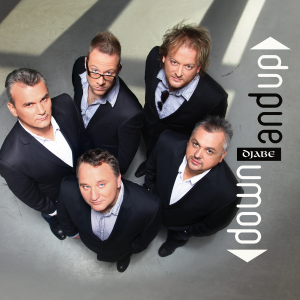
THERE ARE NAMES AND TITLES that I have a hard time memorizing, probably because I associate them with something else. Such was the title of Djabe’s 2012 album, Down And Up, I wrote and said “Down and Out” several times in the early stages of writing this book (I even got shunned by Atti). My only excuse is my bluesy upbringing, as this the term is well known in these circles (Nobody Knows When You’re Down and Out, sung by Bessie Smith).
But in the end, luckily, Down And Upalso sticked with me. Our great teachers said, we cannot know light without the darkness. And also that the road only leads upwards from the deepest point. Although Djabe achieved fantastic success on the concert stage between 2008 and 2011, and they did not reach a low point even after the loss of András Sipos, but it still took time to get out of a kind of creative crisis, which was undoubtedly caused by the absence of Sipi. That’s why the title Down And Upis apt, just as it was obviously a conscious choice that the live debut of the new album took place on November 30, 2012, Andrew’s Day, at IBS.
Although the band looks upwards from the bottom of the cover, after the gripping trumpet intro of the title piece, it reaches the desired height fairly quickly, and the piece takes off with the dignified strokes of a stork. However, Öcsi, Ko (with tango accordion-sounding keys) and the now indispensable Steve take care of the diversity of the above sight.(When I was writing this part and the music was playing, my partner was sitting next to me, crocheting, and her hand was following the rhythm of Down And Up. Or did I just see it that way?)
Take A Deep Breath is anything but a yoga practice, more of a cheerful, funky set free in which Ko produces some sort of 70s Return To Forever solo and makes room for John Nugent’s tenor saxophone. You can associate the melodic dawn mood of Awakening City with everyone’s liking, but I would argue that if we woke up in an atmosphere like this, maybe there wouldn’t be so many nervous, stressful people. Yet sometimes you need nothing more than a little intimacy, a little attention to each other. This is what Attila’s acoustic guitar and the flute of another guest, Gábor Veress, say.
“Only choreographed dancing could be done for this song, because the rhythm section enhances the parade of even and odd beats even by the end,” wrote Károly Libisch about No Chance For Dance, in which Tomi further complicates the tempo, while Attila temporarily calms it down.
Children make a grateful theme not only in cinema, but also in music: Almi & Kitti is for Tomi’s twin girls, full of pure romance and serious playfulness. Let’s not be afraid, because when we think its going to turn into some sweet pop, they’re always stir it up with something unexpected.I Remember, on the other hand, is already a loose ethno-jazz-rock mix in which Ko gives birth to his synth solo from Malik Mansurov’s tar notes so the whole thing starts off and Feri’s trumpet chases Steve’s guitar. Dark Soup has since become a permanent repertoire piece. No wonder, as an Anglo-Saxon rock voice enters Balkan and Central Asian folk music motifs in the first minute. Nothing follows in this piece as much as in I Remember, Tomi leads Feri’s Hungarian insert starting with a “nimble-legged woman” with dreamy bass (after all, it’s a “feeding”…), while in the end Szilu “straightens” the rhythms…
Five Months Later is the most serene piece on the album, conducted by Attila and Feri, although we do hear a few accelerated voices wrapping around it like snakes. Hills of The Valley is once again accompanied by a great ethno meeting, Malik, Kálmán Balogh’s dulcimer, Péter Bede’s flute, while Öcsi’s multi-source violin reacts to Atti’s guitar.
This is how the world village was realized in the Hills of the valley.
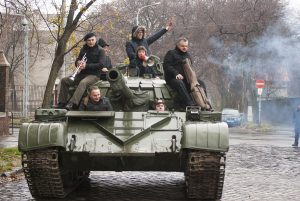
Listen to the creators and actors about the birth of the song and the clip. These confessions were made during the studio conversations mentioned in my Djabe diary.
Tomi: “The theme, the song, was completely different from what I originally thought. We were in Malaysia around Christmas. The environment was completely foreign to us, and in that mood I started writing several songs, most of which were released on Down And Up a few years later. Among them was this, it seemed a bit popy basically, it stayed in a drawer long enough, I wouldn’t have thought it would get on a Djabe record once.It was a working title, Tears for Peace, it came to mind about the band Tears For Fears, a melody reminiscent of the 80s. Later, I deliberately did the arrangement according to the fashion of this age. Since we thought this should be sung, we showed it to Steve. He and his wife, Jo, liked it so much that it immediately inspired them, but they insisted on the title. I didn’t think it could be a kind of a peace song, but I let things go their way. Then, if it is about war, Attila’s tank idea came… ”
“If we put the damn cold aside, the feeling of touching a tank in minus degrees, it was very enjoyable to shoot. We didn’t know what was going to come out of us sitting on a tank and walking around the city, how they would react to it, if people would remember 1956, or the war… ”
“My bass guitar was all the way inside with the case in the tank. I thought I would be in danger of standing among the sharp irons if I pulled out any instrument; or even by a sudden braking…”
Feri: “I was in the Operett Army. I was called in after college, before I joined a symphony orchestra, and after my request was not released, I did five months of labor service with all sorts of prison inmate-types. Great atmosphere. I built a part of the housing estate in Békásmegyer, cleaned guns, took part in shooting competitions. Then I got my pass and played in the army for two years, four months.”
“It was trying to sit on a freezing tank all day, but we had a lot of fun. Steve also did it with great love and self-sacrifice. We had many such experiences with him. In Slovenia we even called him to play football once again, we kicked his hit goal with him… I was the one who took a real instrument in his hand, a metal on another big hunk of metal. Every time I picked it up, it froze on my lips, so I tried to warm it up. But that’s nothing compared to when you have to play live outdoors, like New Year’s Eve. In the cold, the metal instruments go down and the woods go up, till total unplayability. You may need to choose another tone. Fortunately, the music was already recorded for the clip.”
“A lot of people were walking down the street and everyone was taking photos, shouting at us. It was as if someone had said we would start again in March. When a tank was stolen in Budapest in 2006, it was driven by an ex-soldier and to this day it is not clear if it was a pre-planned action… in our case, everyone understood that there was shooting because the tank was being transported on a large truck.”
“People are so overwhelmed with all sorts of influences that I don’t know how to get such a message of peace to them. It was a very interesting series of pictures for me that when in Eastern Ukraine the mothers, whose sons were killed, when the murderous soldiers were caught were not concocted up, but they almost hugged and said: go back and tell your superiors that don’t shoot because you could be our sons… our clip is not far from that either.Or think of the weight of ’56 in the hearts and whether we are prepared for a war situation in our time. How can one come under a command in a military obligation? We’d rather hug the ones we still have… There are laws that can evoke and confuse the environment. If people could see their own desires and opportunities better, they would not run into situations that would force them to sacrifice themselves.”
Ko: “It felt good to do keyboard in a tank, I was a little afraid of the weather, the cold tank, but somehow we still warmed up. It became damp, rainy on the day of the shoot, poor Steve had a hard time, but there was nothing seriously wrong. Anyway, it became an experience of a lifetime, we had a lot of fun, this atmosphere stayed with me the most. We were an exciting phenomenon in the city that many people noticed. I didn’t notice that anyone was scared of us driving a tank on Andrássy Avenue.”
“As a kid, we lived near the Russian barracks, sometimes we even climbed in and then ran. However, this was the first time in a tank.”
Attila: “Earlier songs of Djabe were usually world music-like vocals, or some kind of African motif by Sipi, such was the song Djabe, later clips were more about concerts. Tamás wrote this song, Steve’s wife, Jo, wrote the lyrics that Steve changed here and there as he sang. I thought the song was pleasant, quite popular in nature, though it didn’t follow today’s fashions, and that’s why I wanted a clip to be born for it. The band members all agreed. It also brought some viewers, although it could not be expected that the music channels would keep it on the air all the time, but because of Steve, it was also taken over in many places abroad.”
“I’m a big fan of filming, I also make shots myself with super 8 technique. But here that would not have been enough. My cameraman and friend Iván Vermes and I started discussing what technique we could involve that could even be paid for. We chose 16mm because its graininess fits well with this mood, the effect is more cinematic. Unfortunately, this technology is really out of fashion. The raw material we were shooting for was found partly in Kodak’s warehouse, with an expired warranty, and partly sourced from America. In addition, Iván Vermes is a film cinematographer who had the knowledge and commitment to this work. They tried to convince me, “that it’s going to be good with a video and then we’ll blacken it out,” but whoever watches this clip feels like it has an unadulterated cinematic vibe.”
“We had to find venues that fit this peaceful thing when we listened to Jo’s text, its content was clear. Although these thoughts about Hungary are perhaps a little more general than what we Hungarians, after 1956, feel, because since it was an international production, we tried to illustrate it a little ironically, with the means described. That’s why we chose the tank as a symbol that expresses the absurdity of the world, then we got on it and sang.And on the street, people came, laughed, climbed on the tank, took photos. This is all the good that can happen with a war machine. Some Japanese came, hugged us – that’s what we need to tell the world, to live in peace, side by side. Organizing the tank was really not easy, but we typed www.tankberles.hu into the search engine, and there really was such a page. But the logistics to get to the foot of the VIII. district to be able to shoot on Bronze Sunday, downtown, when the streets are full, it took some serious organizing work. Securing permits, schedules, venues… the camera rental, we had to condense the shooting for two days because of the professionals, and Steve only had that much time. We solved what I could at home, I worked closely with the cinematographer-director, organized, and even starred. Plus, the previous day, November 30, was the album debut for Down And Up, and the next morning we were already shooting. By the time we were performing, the police had already emptied the street at the old Ganz factory. But everyone threw themselves into it with great enthusiasm, so we easily overcame these difficulties. We have only been stopped by police once at Heroes’ Square…”
“The post-production was basically done with a computer. This had to be merged with the music into a complete video stream, which then had to be polished. I cut the material myself. We made the mistake of not using a clapperboard, and since we were shooting without sound, with multiple stops, everything had to be put together and figured out by mouth and hand movements. Ivan finally gave up on this job, at which point I took over and synced for two days. When a huge big matrix came together, I chose what to put in the clip. Then Ivan joined in and we made the final version. The Super 8 had a role in the recordings made on the Columbus ship, where we projected previous films from the Netherlands, and Mongolia, onto ourselves, and they made a special impact.”
“When we turned around on Deák Square with the trailer with the tank on, well, it was a nice stunt. We redrawed the traffic map of Budapest a bit. When it was announced in the Road Information that a road would be closed due to filming, it was a good feeling to know that these are us. It was a success that we were able to put the tank down on the cobblestone. What is also memorable is the cold and the rain. Szilu refused to take out his drums because they would have been ruined for sure, and I didn’t take out my electric guitar either, so I did acoustic guitar. We cut keyboards, making the orchestral packaging smaller than planned. It was suprisingly hard for Steve to climb on the tank, and had to be pushed from the bottom, pulled from the top, put on and he stayed in place till the end. When we stopped to warm up, we wrapped him in blankets and gave him a pálinka; he never drinks, but when we offered him tea, he said that now only a pálinka would help…”
Szilu: “I served in the military as a civil servant, teaching in college. Those years were very important to me in terms of building myself, I by no means wanted to miss them. I will never forget the tank scene. Even since I go on Andrássy Avenue or Heroes’ Square, I often remember that we occupied this area at the time. It was very cold and we worked all day. Anyone who watches the clip doesn’t think about how hard work this is. At the same time, it was a great experience, not only the tank, but the recording on the Columbus ship, with the projections, it had a very amazing effect.”
“I can identify with the thoughts of the song to the maximum, but I have no feedback from viewers on how much the fears of war can be felt.”
“People always like to get involved in a filming. We were also filmed and photographed. I didn’t feel like anyone was scared, and the tank didn’t even moved on on its own track.”
And finally, Steve, with whom Attila talked about his experiences: “I really liked the melody, my hardest thing was the accents. The melody was different from the usual phrasing, it was more jazzy. The vocals were as if a brass band had spoken. I tried singing in different octaves, eventually singing in a high position compared to myself. The message of the song is also good, both locally and globally. There are places where certain Nazi tendencies have resurrected and nationalism is gaining strength. In many places you can travel in Europe without a passport, in other places many look at a stranger with a slanted eye. It would be good if no one was afraid of anyone.Jo, who wrote the text for Tears For Peace, has been very attached to peace all her life. She had to write for the music, that led her. It was only hard for the first time until the music went into her head. People need to understand each other, the impact of war on individuals. For the first time in my life, I sat on a tank. The filming went well organized, it didn’t bother the people who saw it, but rather wanted to take part in it. Of course, it is important that people understand the message of the tank and the text. There was a song by Genesis at the time called The Knife, and people thought we were in favor of militarism.I am a on the side of peace. My generation was very lucky because it was the first to escape the war. My first Hungarian contact was Péter Pallai, a teacher. There were almost only English teachers in my school, my class teacher was a prisoner of war in Japan. The guitar was a symbol of freedom for us too. Musicians are by nature ambassadors of peace by building relationships between different people and cultures. The trouble is, if the speakers are extremists. I also borrow from everywhere, as Djabe does. If Djabe were an English or American band, it would be labeled “progressive” or “crossover”.
If we went back to the village-life approach, the world would be much less of a place.”
Down And Up doesn’t end here, of course, as it’s an enhanced CD once again. We can see a live recording from a Vienna show, Dark Soup and hear a version of Steve Camino Royale supplemented with Djabe that is in a different version and made it to Hackett’s Genesis Revisited II. also. The song was originally the opening track for Steve’s 1982 album Highly Strung, after which he created his own independent record label, Camino Records. It was the opening track of his album. This version was orchestrated by Tomi based on Steve’s narrations and requests, which were based on a 1975 dream in New Orleans. Touring with Genesis at the time, the album Lamb Lies Down On Broadway was unveiled in America. The jazzy tone is no accident…
“Above all, Down And Up is a record with a very fresh vibe, another milestone in Djabe’s successful career. In 5.1 it sounds extremely good, so for those who indulge in this, as well as the imaginative, flirty jazz, prog-rock, complex light and extremely unique musical experience, this is a piece to be on the record shelf, ”JazzMa wrote.
“Listening to the album, we can take part in the fresh, diverse musical journey we are used to from Djabe, and this time the band will show their new faces again. 10 new issues, moods from the experience of recent years – below and above. Tamás Barabás’ bass guitar playing is recognized and loved all over the world. On the Down And Up album, he now plays almost every instrument from which we can highlight his excellent guitar playing. Surely few know that he originally began his career as a solo guitarist. In the last few years, Szilárd Banai has grown into one of the highest-rated drummers, as evidenced by his international accolades. Its unique rhythmic and musical solutions give the compositions an enjoyable color.
Attila Égerházi’s guitar texture has been an essential feature of Djabe’s sound since the beginning. On this album, the tracks Awakening City and Hills Of The Valley represent this world. Ferenc Kovács brings his usual music on trumpet and violin. Of particular note is his interesting lyrics to the song Dark Soup, which he performs in his characterful singing style.
Over the years, Zoltán Kovács’ piano and keyboard playing has become an increasingly important element of Djabe’s music, which convinces us of this release as well, ” Rockstar.hu praised the album.
Djabe wouldn’t be Djabe if the format of this album would be a simple CD. A double LP version of the album was soon released, featuring three sides of original music, and the fourth page features a concert recording of Camino Royale as well as Firth of Fifth and Dark Soup. There was a critic who thought that the vinyl version seemed more important to the band than the CD… and in early 2013 there was already a 5.1 surround sound dvd audio / video version.
 “The title Update was deliberate. Just like Down And Up, the one before. The band had it hard after 2008 but was able to get back on its feet. Almost 4 years has passed since the Take On. We wanted to show we moved on and with the inclusion of the Miskolc Symphonic Orchestra colors and space were expanded on the disc. We always try to keep what’s Djabe for but bring newer and newer elements. Compositions were made basically to give space for the symphonics.” – Attila Égerházi, release of Update (Népszava)
“The title Update was deliberate. Just like Down And Up, the one before. The band had it hard after 2008 but was able to get back on its feet. Almost 4 years has passed since the Take On. We wanted to show we moved on and with the inclusion of the Miskolc Symphonic Orchestra colors and space were expanded on the disc. We always try to keep what’s Djabe for but bring newer and newer elements. Compositions were made basically to give space for the symphonics.” – Attila Égerházi, release of Update (Népszava)
Since then I heard this disc countless times, and of course live too. Yet, I inclined to reach for an earlier criticism by Gepnarancs.hu:
“Sound chakras of freedom
Sound does not have a separate chakra in humans, neither does freedom. And yet, what need do we have to hear and say the sounds of freedom. Luckily humanity has music, this endless, far away yet here-on-Earth dimension. With bits and pieces of the Big Bang, different for every listener, never stopping, never freezing, always going forward, especially when we are unable to shake our self-made ball and chain. With this sound chakra we can gather power to move forward on the road unknown. And this is exactly what Djabe does (once again) with its new album, Forward. The overture starts with the Orchestra, and after a little while the musicians of the band join in – it’s majestic and interestingly playful, serious and inordinate at the same time.
What secrets does our shining maze hides? Lava Lamp is a witch’s cauldron and a white-hot crater and in tis center an eastern fairy world can be heard with genies broke free from their lamps and with wizards conjuring winds. The ancient string instrument of Malik Mansurov, the tar blends into Ferenc Kovács’ s trumpet, John Nugent’s saxophone and Steve Hackett’s guitar with clarity, the motifs becoming one big flower-covered bed. Hang Out tells us not to rush but look around and let feelings, colors and scents close to us and let them settle to make our souls rich with serenity while it also helps us find the rhythm of our breathing with the exotic drums of Gulli Briem, the smiling Icelandic giant. Could it be that only I can hear Arabic, Turkish and Klezmer notes from Mr. East, their co-dependence injected into a vertigo of raga? Subtitles of Life Spirit are helpfully guiding us as it is about a journey through a forest (“midway upon the journey of our life”), meditative notes about becoming one with nature and could be interpreted as somewhat Genesis-like: not only Djabe effects Steve but also the other way around. Wind Tale is the piece of audible pastel colors based on recordings from 2004. Here the inaugurated percussion plays of András Sipos (one of the founders) can be heard. The closer My Day, where band and orchestra blends into each other reminds me to the philosophical truth of living a perfect day is like living a perfect life. And net day everything begins anew. Just like Djabe, with every single album while staying true to themselves.”
A critic of the site Dalszöveg.hu felt the same way I did:
“Forward should be listened only if we have the time to delve into the instrumental layers and atmospheres, and we can shoot our inner movie for it. The title is only a recommendation, with no vocals it is a real unbound experience for every listener.”
Sándor Olasz, a critic of Riff and a long-time follower of Djabe also gave a very positive criticism of the album while also confirmed the band is on the right road:
“In my opinion the requirements for a prevalent fusion between a band (be it rock or jazz or anything) and a symphonic orchestra are these: time, innovation, money. What do you think? I thought I must clarify. Why do I think time is the most important? Because only in a reputable band, successful in its own right, which achieved almost everything in its own category and tried almost every variation, should surface the need for such endeavor. (Let’s quickly forget about the business-based pop types.) Innovation? Yes, it is needed, even now. You cannot succeed by ripping off your own old and well-known pieces with a few sad musicians. New compositions are needed, born and raised for symphonic inclusion. And of course, money… a cooperation with an orchestra costs much, and this “much” need to come from somewhere. However, my solid opinion is that the inner need and credibility are the most important things. Djabe, born under a lucky star, once again supported by their guardian angel and their artistic judgment. Listening to the first piece not knowing what CD you just started you could never say it’s Djabe until the first one third of it because of the dominance of the Miskolc Orchestra. Along the road, however, comes Szilu’s unmistakably tight drumming, followed by the two Kovács with one solo each, and of course Tamás Barabás on the bass. Slowly the picture clears up. In order to make it clear what we are listening to in Lava Lamp (and later in Mr. East) the symphonics are absent. Instead of them we have (along with the Djabe crew) Steve Hackett, Gulli Briem, Malik Mansurov, John Nugent and Ron Stackman. Not a bad line-up, right? This is not the complete guest list; this is only for that one piece! It’s a kind of sparkling and colorful yet compact and weighty almost symphonic sounding so no complaint about hearing it on this exact album. If only we had words instead of amazement. The slowly opening lyrical and mystical Hang Out (with vocalist support) can became a fan favorite of the disc. Twin Pines is a typical Djabe piece, with short but powerful backing from the symphonics. However, Mr. East is a real rarity in its own as never been a Djabe-piece before so eastern in every bit. Now there is! New Worlds give the opportunity to show off the family: Sára Kovács (daughter of Ferenc Kovács) and Sára Égerházi (daughter of Attila Égerházi) have their parts in the piece but this is not the only thing that is going on. Pay attention to the moment when the Orchestra switches to (almost) metal! Life Spirit is a 3-level mini suite: basically, it is lyric where the Orchestra “counts”: underlines, adds. Wind Tale is history come alive: it features 2004 recordings showing not only the ex-member Viktor Tóth but the late András Sipos, a founder of Djabe. Finally, in My Day really comes my day, always when I listen to this fantastic CD (quite often). There is a moral to this story: Djabe plus Orchestra equals explosion. Be careful with the volume setting, don’t blow out the walls.
 How was this album born? How do the band members see it after a year? These are the questions I asked on a studio day mentioned in my Djabe-journal.
How was this album born? How do the band members see it after a year? These are the questions I asked on a studio day mentioned in my Djabe-journal.
Tamás Barabás: “The Djabe sounding evolved along the past years we can already hear into the symphonics: sometimes an orchestra, sometimes a string group rises on the synthesizer. I always hoped that one time we can work with an orchestra. Nowadays it is popular with bands to re-arrange their old pieces for an orchestra or include them in new ones. Here we weren’t going for this as I tried to compose for the orchestra to be one of its own, not only a part of the arrangement. Therefore, we let them play by themselves in the overture with us entering later. It was no easy task to find the right ratio, to keep the Djabe sounding but also have all instruments play, especially with the fortissimos. On the other hand, with the lyrics it was evident what to write for the Orchestra.
My Day was the last to be composed and I felt we need a bass-based piece. It was born like this: I wrote a part on bass and then added everyone else, with me returning to bass motifs multiple times. When finished even I felt surprised what became of this piece that started to be so simple. It was a treat for me.
I always take the musical and human individuality of the band members and guests into account. I know what they like to play, how they like to play, what feels right for them. Without this empathy towards them this whole thing could not work at all. For example, for Malik there is Mr. East. I listened to many tar plays from that region but Malik told me these motifs are not from Azerbaijan but from the neighborhood, Iran. Nonetheless, he felt it as his own, and later asked for the music sheets for performing it with his own band. I never thought I can show him something new…”
Ferenc Kovács: “When the time came for me to record for this album a really beautiful picture of it has emerged and I felt good, I could feel things only to surface later, at the live performance. It was a very complex and serious piece of work even then and it was only to be expanded. And these pieces still have a future. On this album every single composition is loveable because it has some larrikin and pretty parts and our audience responds well to this diversity.
Zoltán Kovács: “A symphonic album was in our heads for years now. In November 2013 we performed with the Miskolc Symphonic Orchestra. Steve was there too, and I arranged two of his pieces for strings. The later cooperation blossomed from this nexus. Then, the April deadline crept on us. I and Tamás was in daily contact with the orchestra. First, I received from him the particello then files containing concepts for expanded orchestra versions. It was a hard and strict duty but as they say, deadline is the best muse.
There are two pieces on the album where the orchestra is absent but are whole, nonetheless. Of course, I would mention Forward first, but I wouldn’t rank after that. Another great experience for me: at the academy I was required to conduct but very rarely had anyone to conduct, and now it was fantastic to coordinate this many people, to make their concepts into reality. They were quite open with us and we received a ton of positive feedback. Classical musicians usually are open-minded when it comes to performing with less strict limits.
Attila Égerházi: “Besides we composed a somewhat regular material we needed to shift up as we needed to think in a much bigger sound stage not in a Djabe symphonic where a piece has strings instead of synth. Here a 57-member orchestra operated, strings, winds, harp, celeste… For the orchestra sheets we had a composer in house, Zoli Kovács, who had no problem composing the pieces imagined by Tamás. Finally, pieces became just what the guys imagined. Everyone was enthusiastic. Szilárd asked us to let him record his drums at home, but Feri also put himself on the line. I think the results can clearly be heard. We could rely on our friends: Steve, John Nugent, Gulli Briem, Malik Mansurov (who had a much bigger role we originally planned). The only reason we didn’t include them in more pieces is that way those would be impossible to perform without them. By the way Djabe members would be enough but we are accustomed to being open-minded and receiving inspiration from our guests, and we love to channel this towards our audience.
My favs? From my own compositions, definitely Life Spirit, born from a strong inner motivation. The wave that carries through it mirrors changes in my own spiritual state, with the end transforming into something instinctually Genesis-like. In the middle I play on classic guitar with the Orchestra backing me and I am very proud of this sounding like as it is. Another great experience was the piece we try to do since 2004: Wind Tale was started by Sipi and me long time ago. My old friend and peer can be heard in this one – and not by some track subtracted, this is a then-begun and now-finished composition and recordings. From Tamás I really like the closer My Day where the whole band backs the bass guitar. I waited for a long time for Tamás to do a fretless bass-based composition. I love Forward, its symphonic part has a life of its own – as it does on the LP version. One of my favs is Mr. East, composed precisely for Malik by Tamás.
Szilárd Banai: “It is definitely a milestone of Djabe. When I recorded my drums, the symphonic recordings were yet to be done so I only heard the final stuff. This is an album that can be listened to anytime as it has so rich a sounding, so colorful, so diverse. Although it’s not typical of me to listen to anything I feature in.
I done a portion of my recordings at home so it was a good experience not to start a studio day by packing, boxing, filling up a van, drive for kilometers, unpack in the studio, unbox, connect everything and when finally able to play there is no energy and spirit left in me. This joy can be felt on the album. Piano and bass parts were made in the same manner. It’s a really big deal that technically this can be done.
With Gulli we have something of a nexus, something that works for both of us. He is also a very sensitive musician and pays attention to every detail. We both approaches drumming from the musical side. With our instruments there are plenty workmen around and much less artists. Of course, there is plenty to learn but you also need to forget those because it is very important to listen to your inner, instinctual voices, not rely on what you learned. It’s simple but rare. Gulli has this and this is why we understand each other, both as musician and as an individual.
As referenced by Attila, Forward continued the series of Djabe LPs. This is a double vinyl with the 4th side dedicated to the Forward Symphonic Suite and the other 3 contains the original material of the CD. For a treat the CD is also included, with videos of the recordings done by the Orchestra and the band, titled Strings are Moving Forward. Not long after a DVD-Audio format also released.
This consistent LP project and releases in multiple formats were visited in an interview with Attila, published by Gramofon in the Autumn of 2014:
“For the artist the goal is to finish the musical product. It can be finished as a digital format, but physical medium gives a lot extra to it. There is the cover, expanding the world of said product with an artwork that can provoke thoughts, support the content, especially in the case of the so-called conceptual albums. It is evident the Bakelite or vinyl format endured, so the experience provided by a turntable considering quality and sound characteristics, it requires a more serious listening and cannot be replaced. It’s not the same as listening to music in the car on a CD or coming from the computer in the background. This is something to motivate the artists…”
Luckily the fandom of physical media starts to reemerge as does the music listening culture. I think digital downloads cannot completely eradicate the physical media and we consciously vouch for these formats as long as possible. We plan for a long, long time. We hope our music will be of interest from 50 or 100 years from now and if it exists on numerous physical media it has a greater chance of survival. Digital download can reach so many places but if the servers ever get erased there is no way back…”
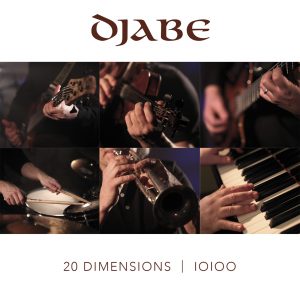 We are invited for a science experiment. The like of which many want to conduct, by invoking any method: to expose ever more time and space. There’s no need for spaceships, large telescopes or hadron colliders, just some imagination and of course five musicians and a few guests. This is how 20 Dimensions invites us (the title on the cover is also featured in binary, as 10100). The cover photo features 12 hands in action (Feri stars twice as he plays both the trumpet and the violin).
We are invited for a science experiment. The like of which many want to conduct, by invoking any method: to expose ever more time and space. There’s no need for spaceships, large telescopes or hadron colliders, just some imagination and of course five musicians and a few guests. This is how 20 Dimensions invites us (the title on the cover is also featured in binary, as 10100). The cover photo features 12 hands in action (Feri stars twice as he plays both the trumpet and the violin).
With the sci-fi esqe overture and the also mystical close (more on that later) we hear 20 pieces close context to each other. 9 new pieces linked by 9 transitions, the latter born from the improvisations of band members and guest musicians. As accustomed to Djabe there is no two with the same tempo, structure or mood, but still, all of them fits together and makes a whole: the new pieces can be interpreted as moments of wonderment about a newer dimension while Transitions show us the strange excitement of travel.
Sensitive World is a lively Rock-Jazz piece with John Nugent as guest, while Sunday Afternoon builds around a child song-like motive started and ended by Feri Kovács and Zoli Kovács with their artistic piano-violin duo. 4000 is a kind of prank as after 2 minutes of slow and meditative keyboard comes an explosion of bass by Tomi Barabás to pump it up. It’s no surprise that after this strolling and rushing shifts constantly. In Space Castle there is nothing space-like but we can imagine Earth’s numerous areas featuring in this cosmos, from the Balkans and the Arab world to India (with tablas played by Tibi Mótyán), while the piano and Ben Castle’s soprano saxophone summons the mainstream of 70s USA, and Szilu creates something unstoppable on his drums. Waves From The System dissolves from Attila’s guitar accords, making place for a freedom of musical associations and genre shifts unseen before.
Here, Tomi lets his signature-like slap loose and we even get a bit of the psychedelic. In Intermission the atmosphere of Ice World and Life Spirit makes an appearance, the former by Feri’s majestic trumpet, the latter by Atti’s guitar play – and became one of the most loved pieces. In Arena 87 Tomi gives a baseline on synthesizer – this may be the example piece for Djabe’s indicated course line of the past years, with an added Steve Hackett solo.
Klang is the latest instrument amongst Attila’s discoveries, and blossomed into the Klang Song, one of the most layered and clean, real contemporary pieces. Then there is Tomi’s Come Here, an example for a bass player gone berserk, a piece for dancing and partying. I can really envision listening to this Floyd-like overture.
There are some de facto masterpieces among the Transitions, too. The 1st is statically teems with sounds, Sára Kovács (daughter of Feri) says hello on didgeridoo while his father plays the trumpet like Miles Davies in In A Silent Way and Zoli Kovács improvises almost avantgarde roulades, and even the electronic guitar makes an appearance from the background. The 2nd has Malik as the hero, his garlands of tar are only chaperoned by Sára’s flute. The 3rd once again features the Azeri tar, answering to the violin. The 4th is my favorite, possibly because Malik’s tar, Attila’s acoustic guitar and Feri’s violin play reminds me of the atmosphere of Page-Plant duo’s Moroccan adventure. With its mysterious electronic guitar, the 5th could be an early example of prog rock but the Azeri tar spills over it. I always liked piano-wind duos, and this wish is granted by the 6th. Listening to the 7th we almost expect Sipi to interrupt – it’s so like Ly-O-Lay Ale Loya. Ever wondered what a Central European and Central Asian duo of grief sounds like? Just listen to the 8th with the sounds of violin and tar. The last one is a kind of summary for all the travels we did. Even the longest Transition is only 2 minutes long, with not one unnecessary note! The closing piece Out Of Dimensions, with Atti’s music and the narration of Hans Petersen (heard before in the overture) is a kind of Djabe Ars Poetica.
“If you look far enough and break down your boundaries
You’ll see new close-ups from many aspects.
These aspects are dimensions without limits you’ll have to try.
The twentieth dimension seems like a conclusion – but after twenty, twenty one is the next.”
“First we thought of a completely acoustic album but after that came the multitude of electronic elements. Tomi had the idea to do these pieces as dimensions of the past 20 years, new music spawn from them. So, we look forward. We wanted to give some kind of explanation for this shift, like with Update. I wrote the closing narration. Originally it was ment as an opening and was on top of one of my pieces composed for the album. Here, the music sounds just as I recorded the demo. But Tamás suggested this would rather be the closing. And to be honest, it sounds really good this way, it can be interpreted as a summary of our musical approach. In contrast, I wrote an opening that is much more scientific. This is how a complex frame for a complex album was born.” – Attila Égerházi.
The band leader also told that he wanted the Transitions to blend more into their respective pieces and it is possible that Djabe makes more adjustments for the LP release.
“There are no words for describing last night… I thought really hard how to do it when I went home… and finally found the expression doing justice… If someone, in some form, would shoot this new CD out to space maybe the aliens would reach for their musical instruments, too.” – by a member of the audience on the next day of the concert, posted on the band’s Facebook page.
Jozé also praised the album in his criticism on the pages of HammerWorld.
“20 years, 20 tracks. This is to summarize the new studio album by Hungary’s #1 World/Jazz/Prog fusion band, which is a kind of “return to the roots” and once again shows Djabe’s acoustic, atmospheric, meditative and fusion side, with a hint of modern electronica. The 20 tracks, or dimensions have a framed structure. at the beginning the concept of the album is drawn up, and the 20th piece is a philosophical summary of all the things heard and a guide for things that will be. The past 20 year is perfectly summarized by the armada of guest musicians, the featuring of past soundings, orchestrations and sound effects, the incorporation of archive recordings and other small bits and pieces. There are but only few this close to the otherwise unachievable musical perfectionism. The band of Attila Égerházi once again released a real masterpiece, one of the best albums beyond dispute. It is destined to become a yardstick, globally even. Suffice to say, the summer premiere tour reaches across the Atlantic. The pieces of this new album are linked by improvisations (not unlike Pink Floyd’s Endless River, here called Transitions 1-9) and expanded by archive or almost finished recordings made whole. The compositions of Barabás are, as accustomed to him, lively and sweepingly virtuoso, the ones co-composed with Égerházi are more akin to the original Djabe with a thought-provoking, serene, almost lyric style. The latter calls to my heart as once again (like their first album, one of my all-time favorites) with its calm, somewhat introverted mood sending me on a meditative travel inwards. Another “back to the roots” is the heavily featured acoustic guitar and the emphasis on the violin, compared to previous albums. All of today’s virtuoso Djabe members and the illustrious guest list (Steve Hackett, Malik Mansurov, John Nugent, Ben Castle, Tibor Mótyán, Sára Kovács, Hans Peterson) has its place and function. These multiple dimensions make up a whole. The band named after freedom once again made a statement on the side of artistic freedom, unbound by genre-specific limits and expectations. Not since the first album I felt a world of a Djabe CD so near, so familiar to myself. Listening to it again and again I feel te urge to reach for my guitar. Attila Égerházi and the band made a real synthesis of their last 20 years, with this opus. They came in full circle, returned to the source, to the roots of Djabe. Featuring a few (never performed) compositions from the first album along the material from the new one at the 20-year Anniversary Concert at MOM on April 1, 2016 is unique but not at all random, as said debut album’s re-release in 5.1 DVD-Audio is due. I eagerly await this new direction, the latest update, the 21st dimension. Be it a double LP/DVD-Audio edition, and the next era after completing this circle.”
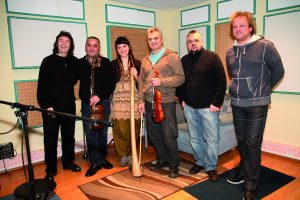 Another criticism from Dusk.
Another criticism from Dusk.
“20 Dimensions feature 20 tracks of pleasant, catchy pieces born in elegant fusion, advanced by Tamás Barabás’ s fretless bass and the synergy of the virtuoso performance of his peers.” – said Mario Giammetti, and highlights Klang Song, its unique structure and shifts in accords implemented uniquely in Steve’s solo. And what of the 21st dimension? The planned unplugged? An even more detailed meeting of the roots and the 21st century? A synergy of arts maybe? In an interview in March 2016 Attila made some hints of a sequel to Seafs as a 15th anniversary of the original release. But let’s see, what wasn’t tried by the boys already? Their pieces incarnated as choreographies, clips, but no all-night dance suite, no feature film – these could tell us about the inseparability of the human intellect of the 5 continents, with just Djabe tunes…”


